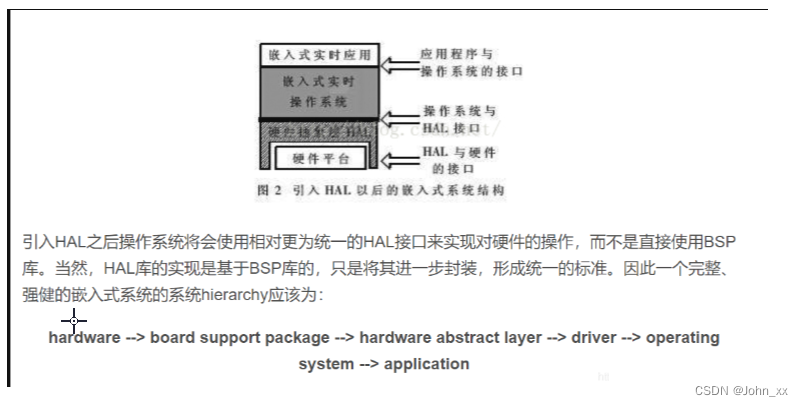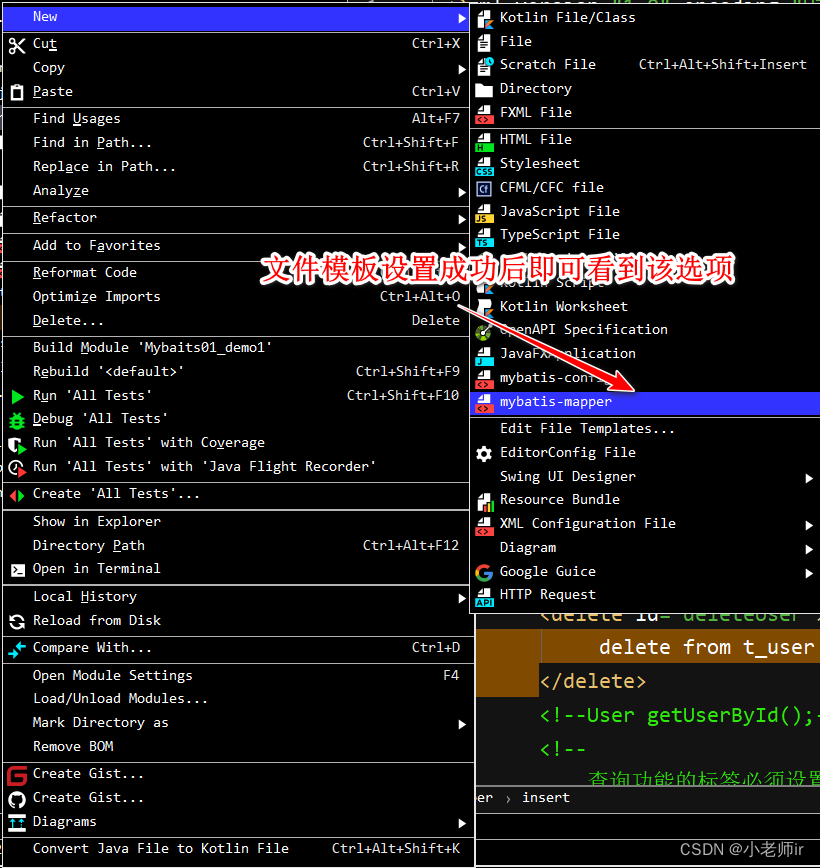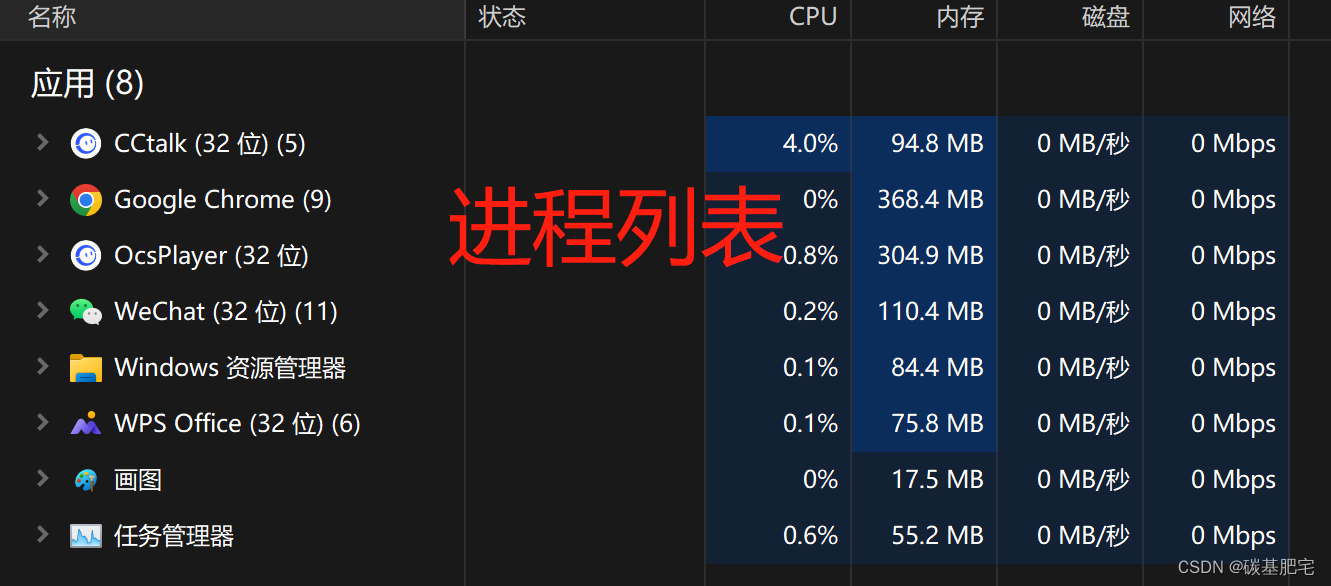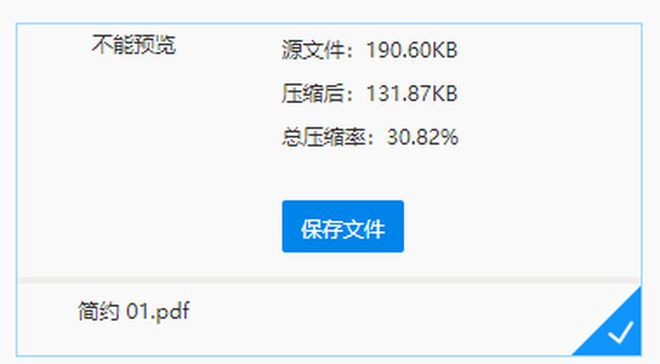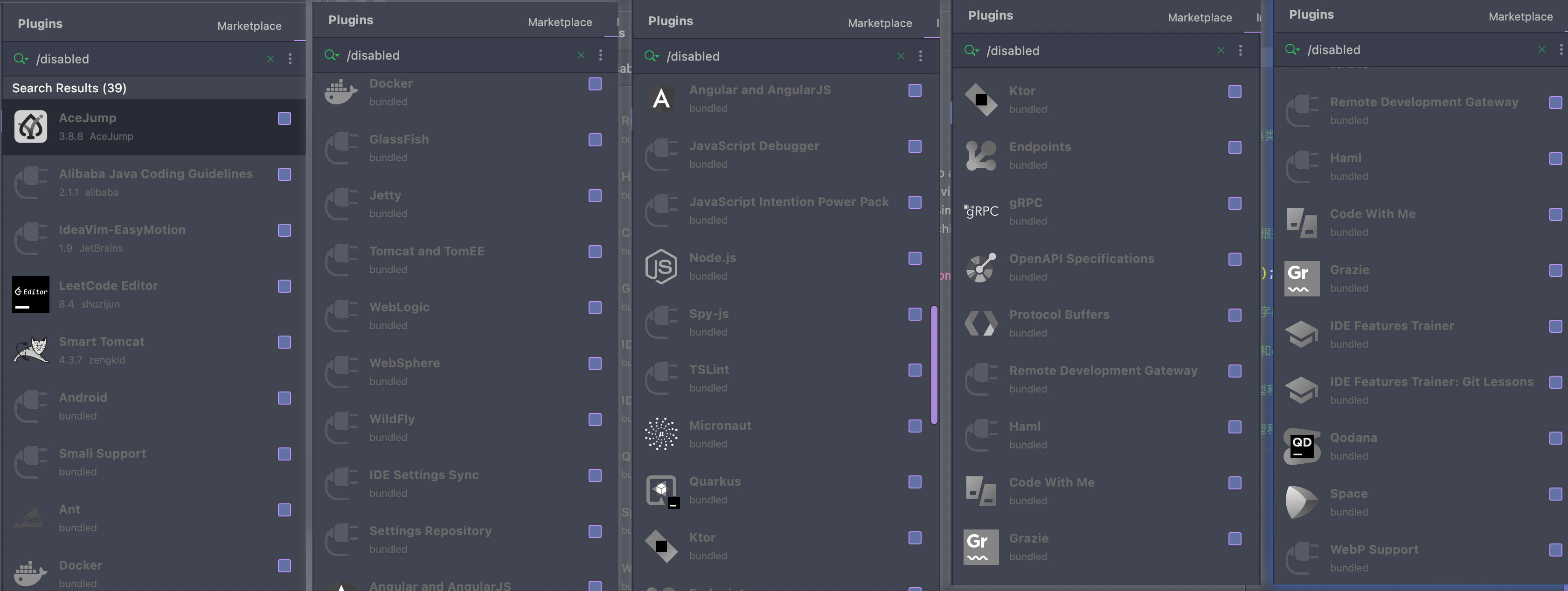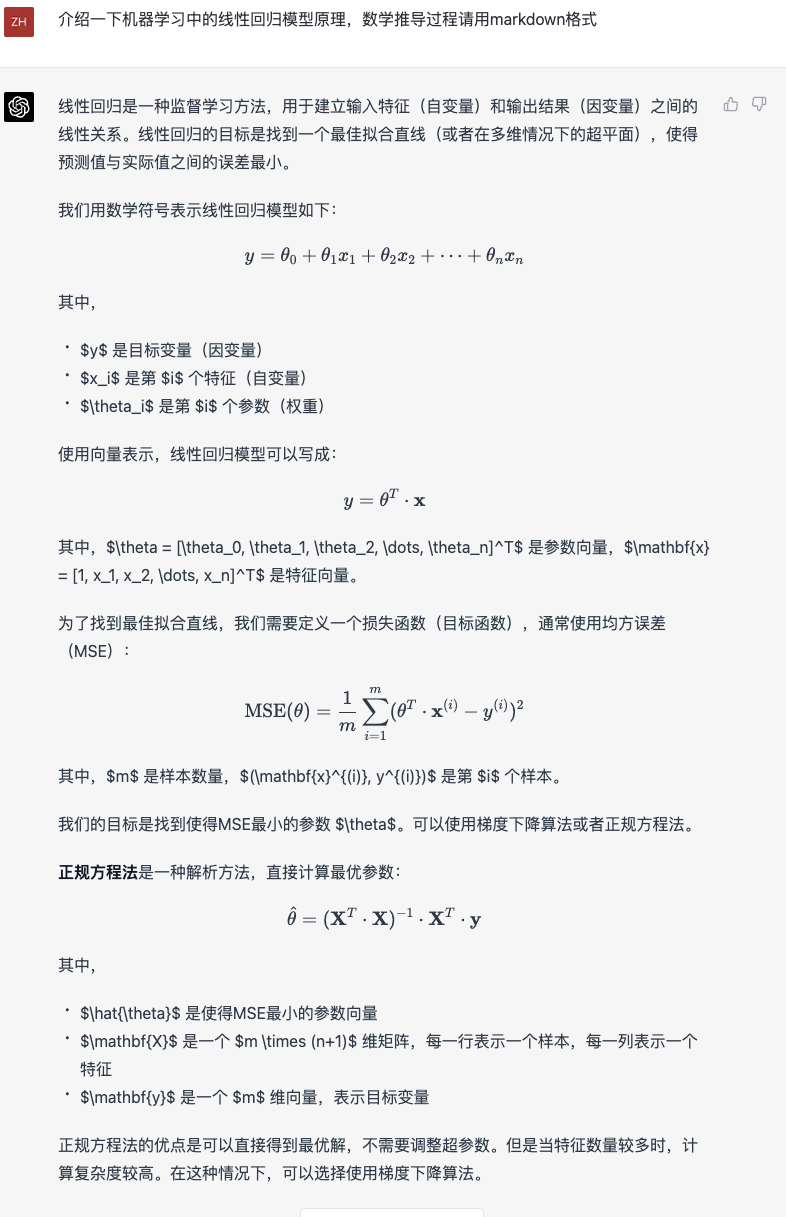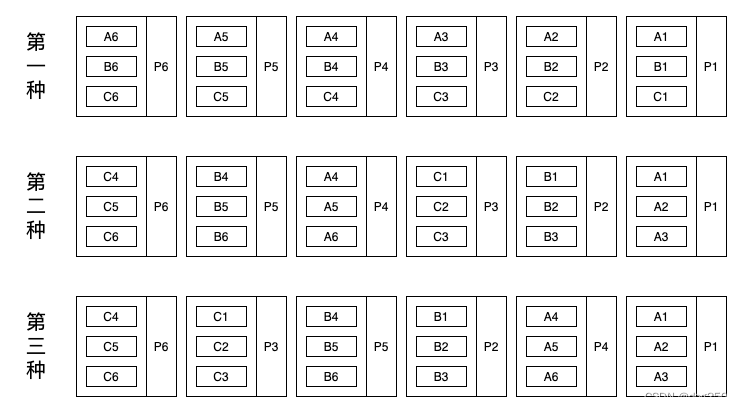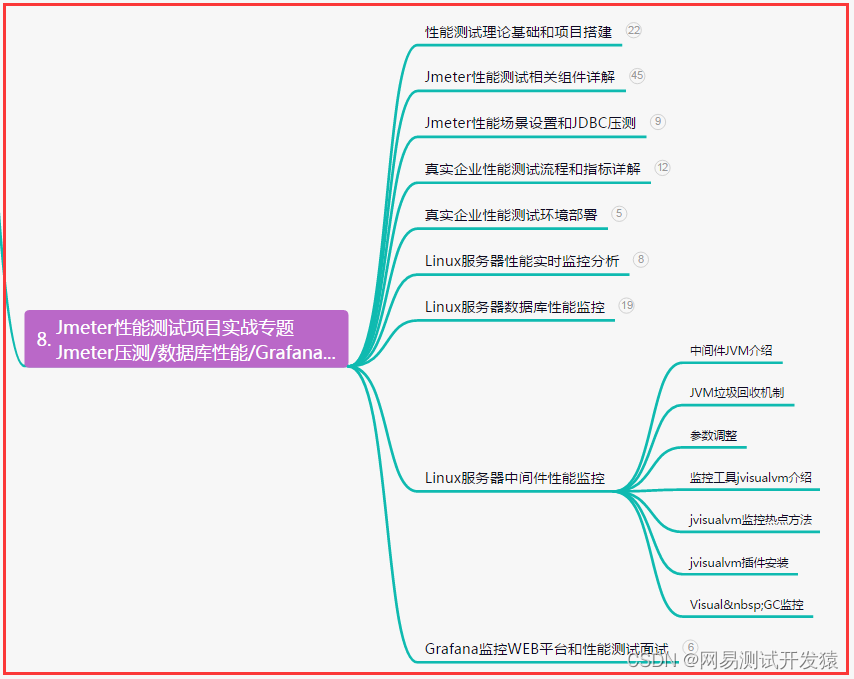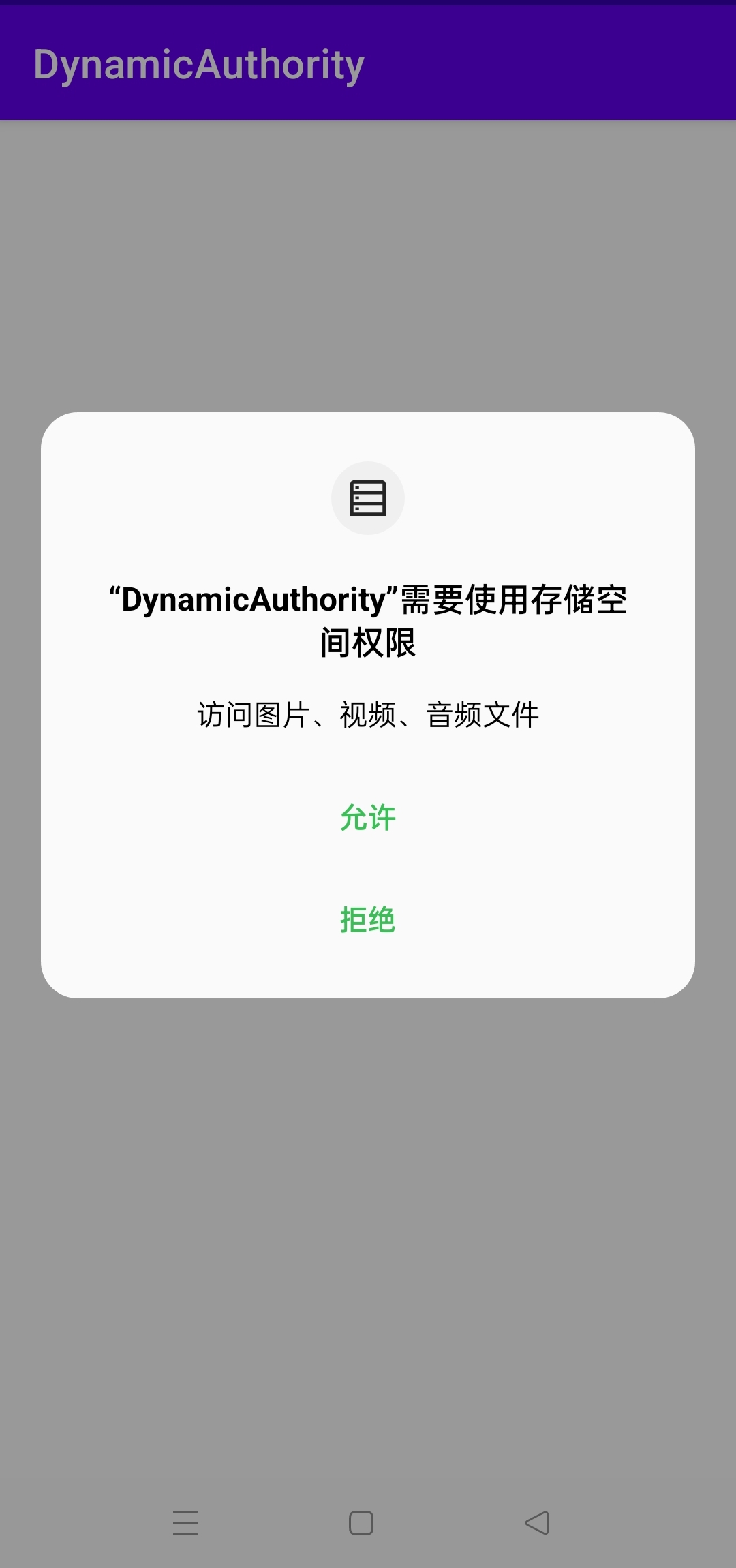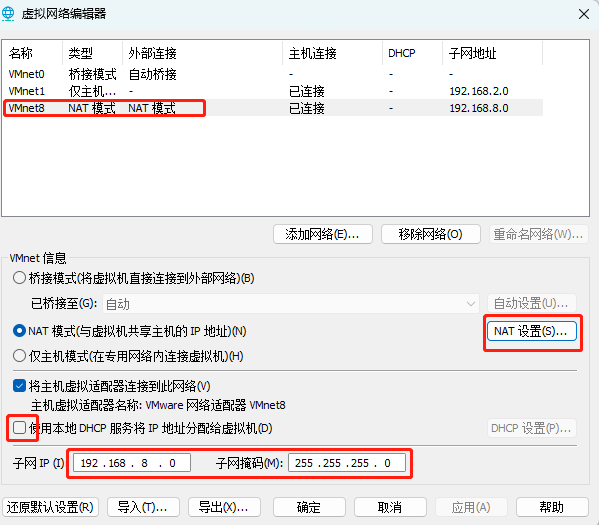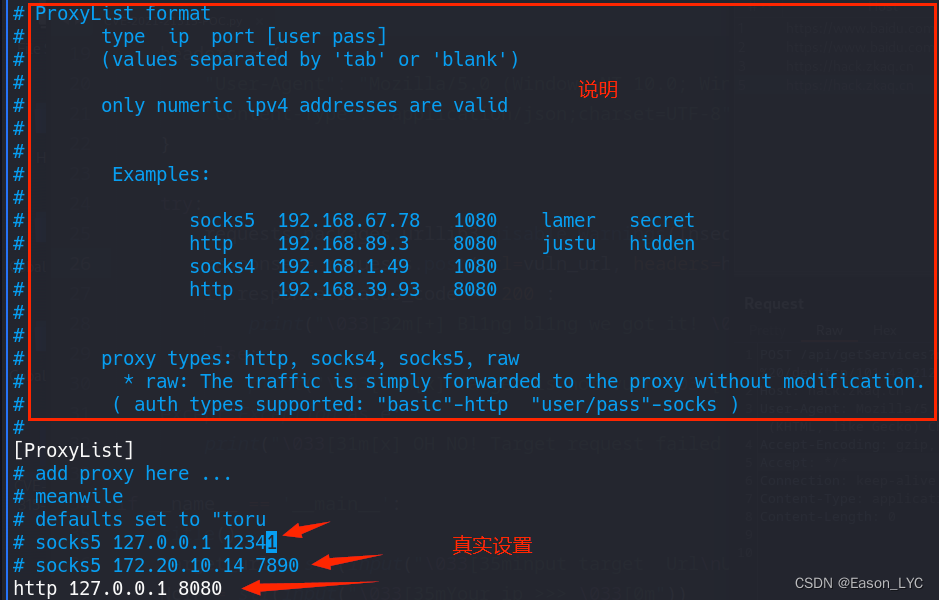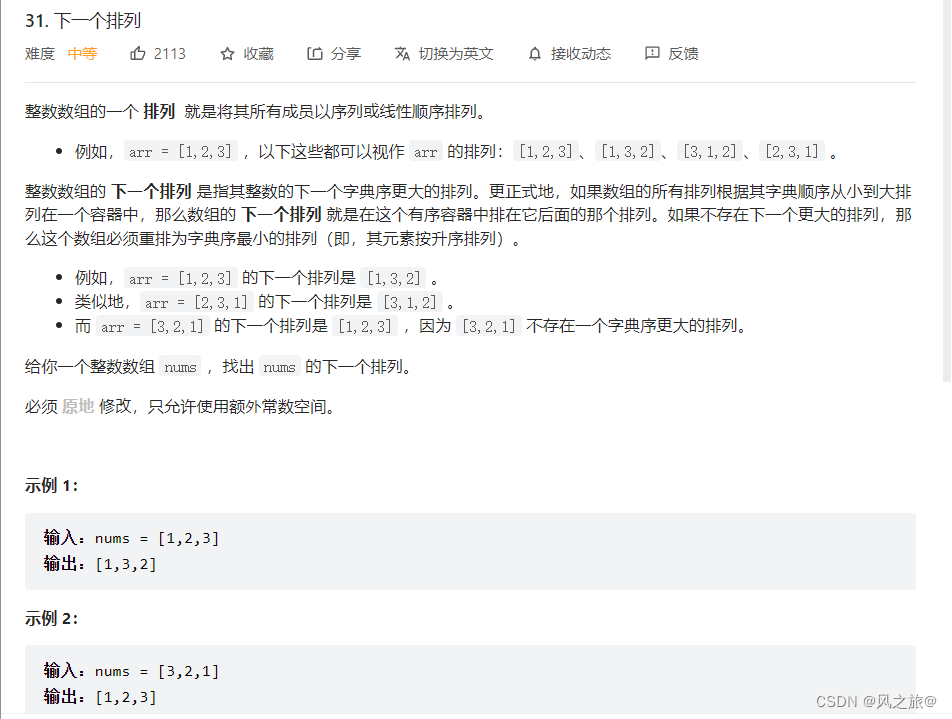目录
- 一、准备工作
- 二、引入依赖
- 三、创建必要的目录
- 四、编写代码
- 五/六、打包部署(直接基于 smart tomcat)
- 七、验证代码
- 正式编写服务器代码
- 编写数据库相关的操作代码
- 创建数据库/表结构(数据库设计)
- 数据库代码
- 封装数据库操作
- 封装针对数据的增删改查!
- 博客列表页
- 约定前后端接口
- 编写服务器代码
- 编写客户端代码
- 问题一:
- 问题二:刷新页面的时候,发现一哆嗦~
- 博客详情页
- 约定前后端交互接口
- 前端代码
- 登录页
- 约定前后端交互接口
- 后端逻辑
- 约定前后端交互接口
- 正确显示用户信息
- 针对博客列表页
- 针对博客详情页
- 实现"注销"功能
- 约定前后端交互接口
- 发布博客功能
- 约定前后端交互接口
- 删除博客
- 完整代码
一、准备工作
打开你的idea,创建一个Maven。
-
File->new->Project;
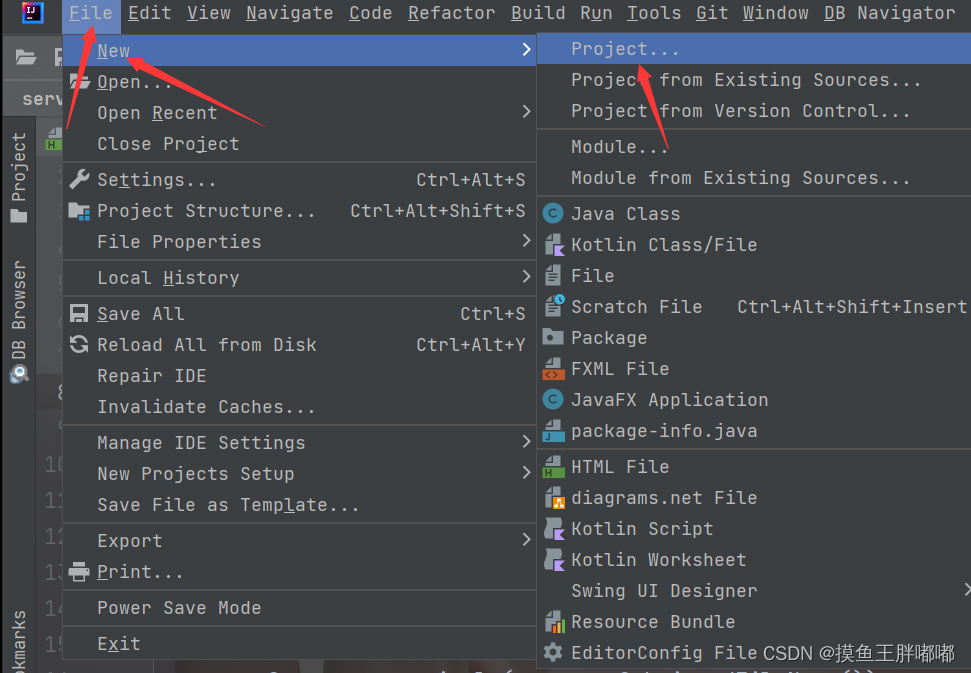
-
选择创建maven项目,然后点击next

-
取个名字

二、引入依赖
这里我们需要引入的依赖是servlet,jackson,mysql。
这个操作嘛!直接看JavaEE-实现一个服务器版本的“表白墙”
里面有引入依赖的相关操作~
pox.mal
<?xml version="1.0" encoding="UTF-8"?>
<project xmlns="http://maven.apache.org/POM/4.0.0"
xmlns:xsi="http://www.w3.org/2001/XMLSchema-instance"
xsi:schemaLocation="http://maven.apache.org/POM/4.0.0 http://maven.apache.org/xsd/maven-4.0.0.xsd">
<modelVersion>4.0.0</modelVersion>
<groupId>org.example</groupId>
<artifactId>blog_system</artifactId>
<version>1.0-SNAPSHOT</version>
<properties>
<maven.compiler.source>8</maven.compiler.source>
<maven.compiler.target>8</maven.compiler.target>
</properties>
<dependencies>
<!-- https://mvnrepository.com/artifact/javax.servlet/javax.servlet-api -->
<dependency>
<groupId>javax.servlet</groupId>
<artifactId>javax.servlet-api</artifactId>
<version>3.1.0</version>
<scope>provided</scope>
</dependency>
<!-- https://mvnrepository.com/artifact/com.fasterxml.jackson.core/jackson-databind -->
<dependency>
<groupId>com.fasterxml.jackson.core</groupId>
<artifactId>jackson-databind</artifactId>
<version>2.12.6.1</version>
</dependency>
<!-- https://mvnrepository.com/artifact/mysql/mysql-connector-java -->
<dependency>
<groupId>mysql</groupId>
<artifactId>mysql-connector-java</artifactId>
<version>5.1.47</version>
</dependency>
</dependencies>
</project>
三、创建必要的目录
点开我们项目下的src文件,找到main,然后右键创建一个新的目录,webapp;在webapp下创建一个目录叫做WEB-INF,然后在WEB-INF下面创建一个新的xml文件叫做web.xml
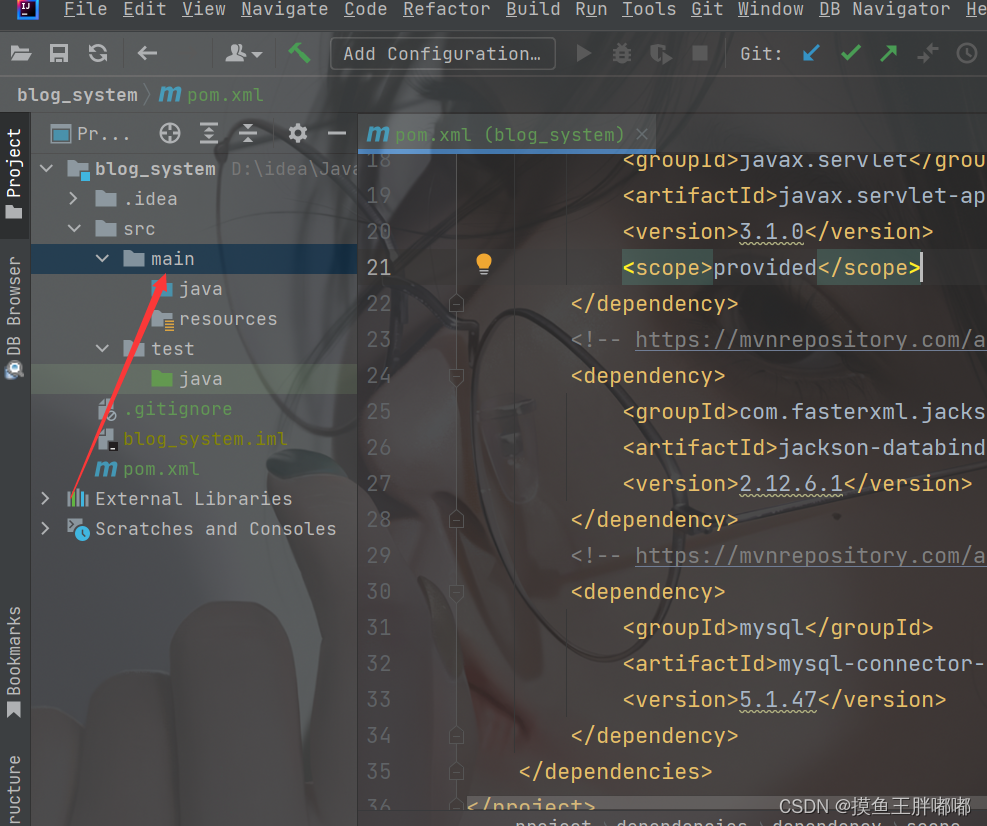
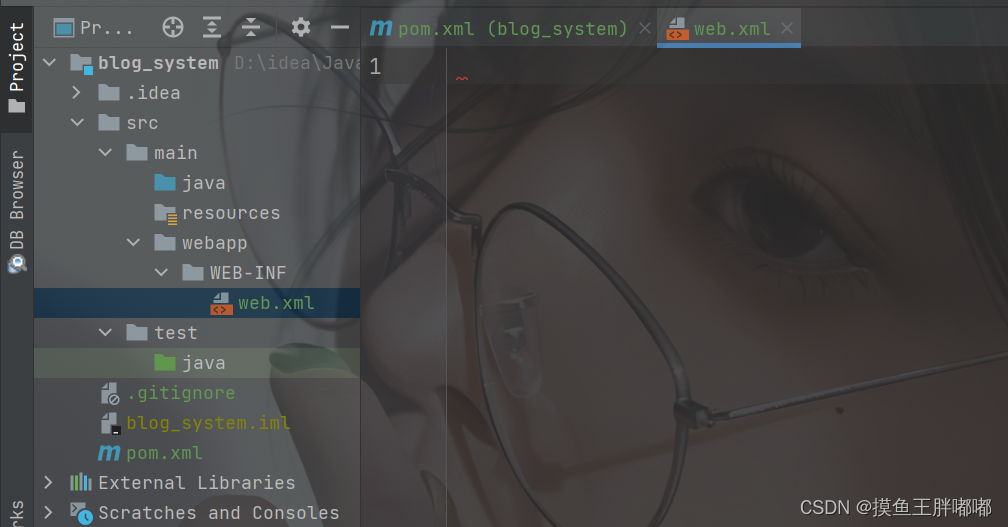
在web.xml文件中填写以下代码
<!DOCTYPE web-app PUBLIC
"-//Sun Microsystems, Inc.//DTD Web Application 2.3//EN"
"http://java.sun.com/dtd/web-app_2_3.dtd" >
<web-app>
<display-name>Archetype Created Web Application</display-name>
</web-app>
四、编写代码
找到java文件,在java文件下创建一个类叫做HelloServlet

写一个简单的实验代码
import javax.servlet.ServletException;
import javax.servlet.http.HttpServlet;
import javax.servlet.http.HttpServletRequest;
import javax.servlet.http.HttpServletResponse;
import java.io.IOException;
public class HelloServlet extends HttpServlet {
@Override
protected void doPost(HttpServletRequest req, HttpServletResponse resp) throws ServletException, IOException {
resp.getWriter().write("你好,博客系统!");
}
}
五/六、打包部署(直接基于 smart tomcat)
这里打包部署在博主之前的博客已经介绍过,使用idea自带的插件smart tomcat来完成
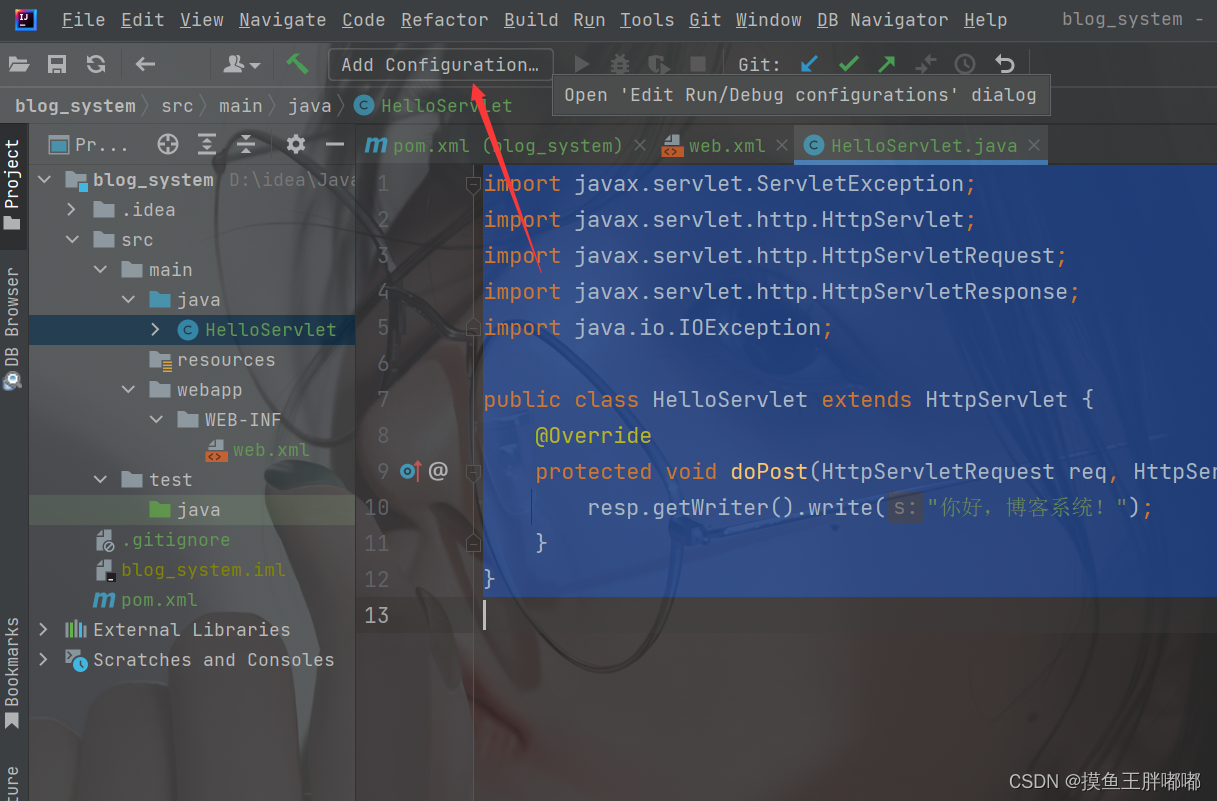
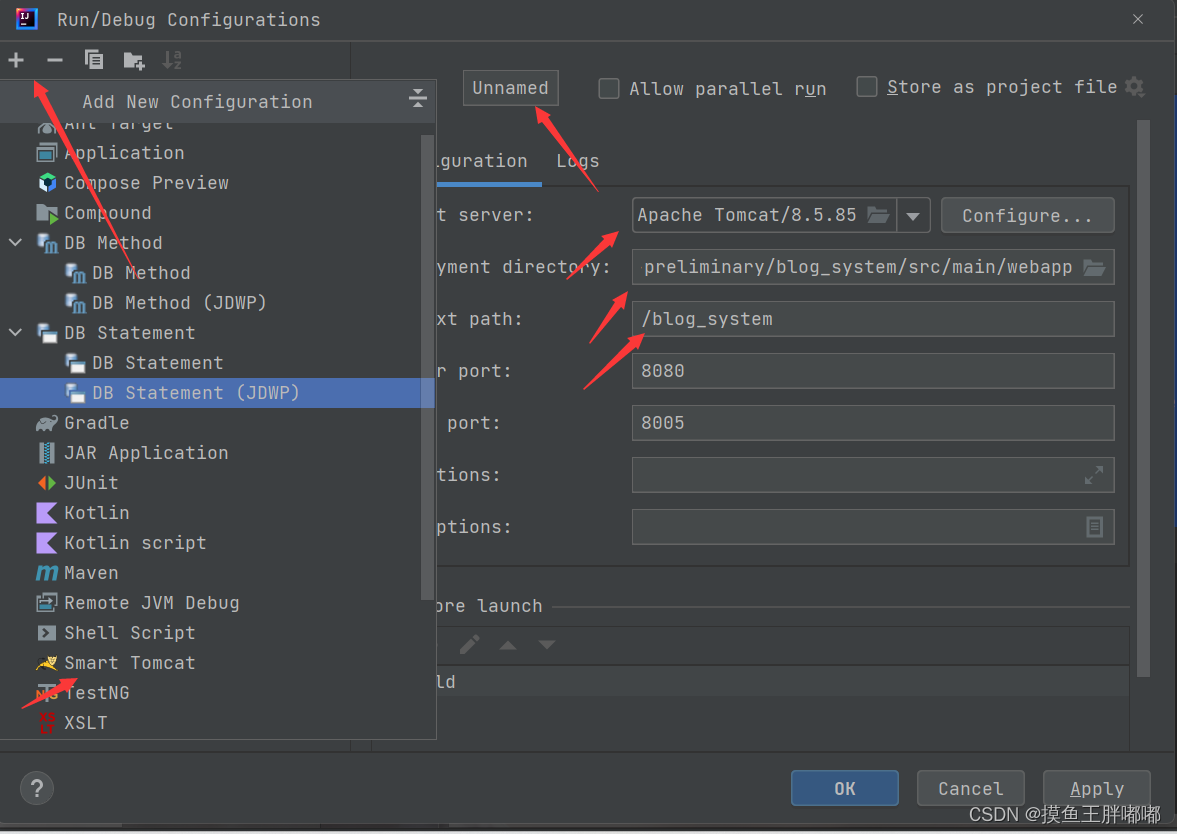
七、验证代码
在浏览器验证程序。
正式编写服务器代码

找到我们以前的博客系统的前端代码,然后复制粘贴到当前的webapp目录下
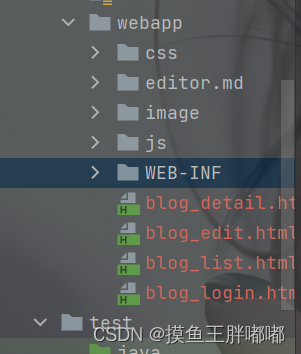
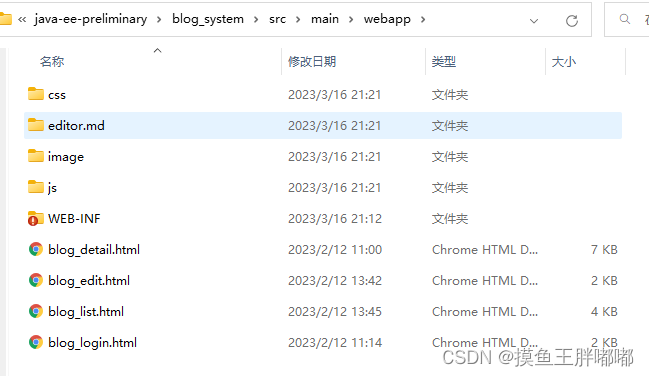
就可以把前端页面给引入项目中。

C和M,先来实现Model层~~ 先来实现数据库相关的代码
编写数据库相关的操作代码
创建数据库/表结构(数据库设计)
设计数据库,需要根据当前的需求来进行设计~~
这里来介绍一下前面写的博客系统页面:
1.博客列表页:显示博客的列表;
2.博客详情页,点击博客列表页,上面列出的博客篇数,可以跳转到完整的博客内容;
3.登录页面;
4.博客编辑页,基于editor.md整了一个markdown编辑器,根据这个页面来发布博客
存储博客~当点击发布的时候,博客被发布到服务器上,就要被存起来
获取博客~当博客列表页和博客详情页,能够拿到博客的内容,还能够进行登录校验
设计表,就需要抓住需求中的实体(关键性的名词)
博客表,用来存储所有博客数据~
用户表,用户登录,就需要用到这个表~
数据库代码
-- 编写建库建表的 sql
create database if not exists java107_blog;
use java107_blog;
-- 创建一个博客表
drop table if exists blog;
create table blog (
blogId int primary key auto_increment,
title varchar(1024),
content mediumtext,
userId int, -- 文章作者的 id
postTime datetime -- 发布时间
);
-- 创建一个用户表
drop table if exists user;
create table user (
userId int primary key auto_increment,
username varchar(128) unique, -- 后续会使用用户名来登录,一般用于登录的用户名都是不能重复的
password varchar(128)
);
insert into user values(null, 'zhangsan', '123');
insert into user values(null, 'lisi', '123');522215
编写完成之后,打开mysql客户端,然后复制上面的SQL语句,粘贴到我们的mysql客户端
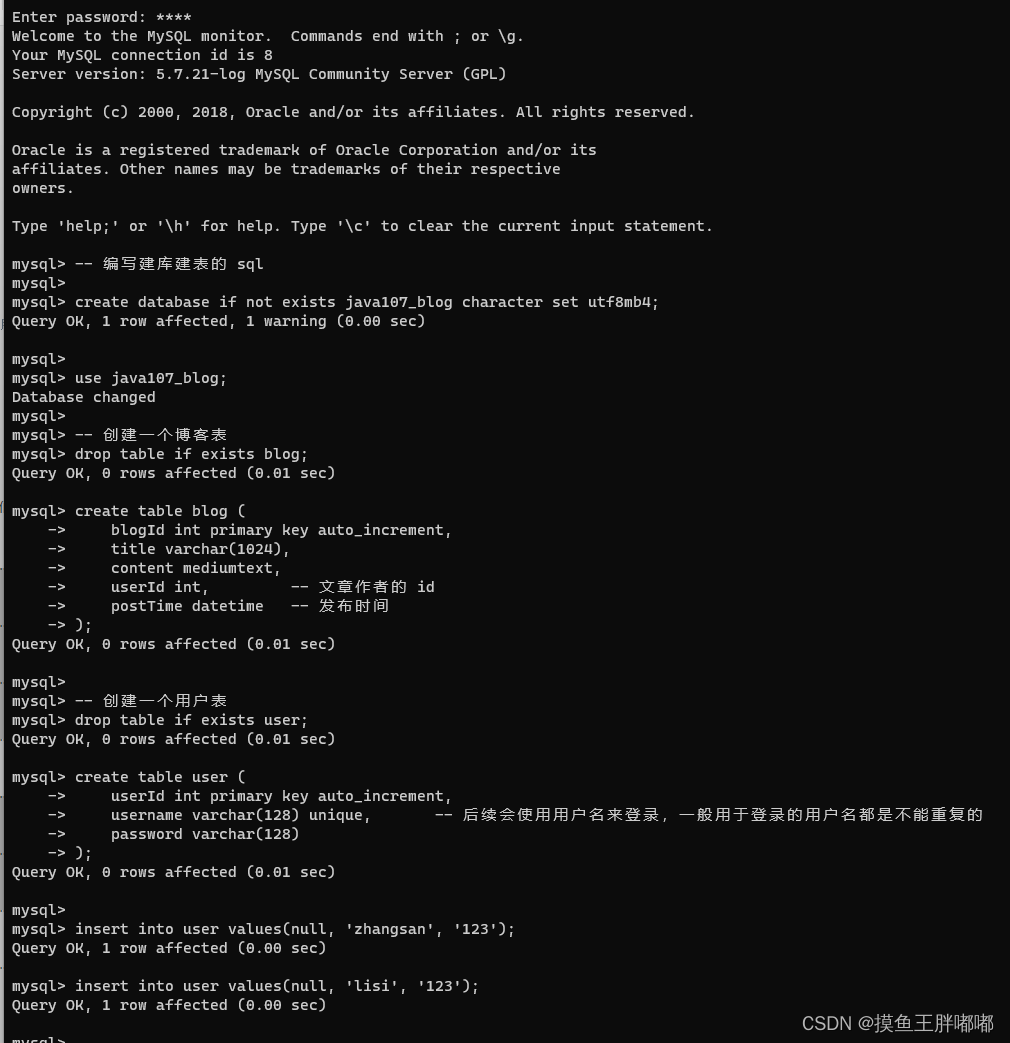
检查数据库和表是否创建完成

封装数据库操作
先创建DBUtil封装数据库连接的操作
import com.mysql.jdbc.jdbc2.optional.MysqlDataSource;
import javax.sql.DataSource;
import java.sql.Connection;
import java.sql.PreparedStatement;
import java.sql.ResultSet;
import java.sql.SQLException;
// 使用这个类和数据库建立连接
public class DBUtil {
private static final String URL = "jdbc:mysql://127.0.0.1:3306/java107_blog?characterEncoding=utf8&&useSSL=false";
private static final String USERNAME = "root";
private static final String PASSWORD = "1234";
private static volatile DataSource dataSource = null;
private static DataSource getDataSource() {
if (dataSource == null) {
synchronized (DBUtil.class) {
if (dataSource == null) {
dataSource = new MysqlDataSource();
((MysqlDataSource) dataSource).setURL(URL);
((MysqlDataSource) dataSource).setUser(USERNAME);
((MysqlDataSource) dataSource).setPassword(PASSWORD);
}
}
}
return dataSource;
}
public static Connection getConnection() throws SQLException {
return getDataSource().getConnection();
}
public void close(Connection connection, PreparedStatement statement, ResultSet resultSet) {
if (resultSet != null) {
try {
resultSet.close();
} catch (SQLException e) {
throw new RuntimeException(e);
}
}
if (statement != null) {
try {
statement.close();
} catch (SQLException e) {
throw new RuntimeException(e);
}
}
if (connection != null) {
try {
connection.close();
} catch (SQLException e) {
throw new RuntimeException(e);
}
}
}
}
创建实体类!
使用实体类表示数据库中的一条记录
此处主要创建了Blog类和User类
User类
// 每个 User 对象,对应 user 表里的一条记录
public class User {
private int userId;
private String username;
private String password;
public int getUserId() {
return userId;
}
public void setUserId(int userId) {
this.userId = userId;
}
public String getUsername() {
return username;
}
public void setUsername(String username) {
this.username = username;
}
public String getPassword() {
return password;
}
public void setPassword(String password) {
this.password = password;
}
}
Blog类
import java.sql.Timestamp;
// 每个 Blog 对象,对应 blog 表里的一条记录
public class Blog {
private int blogId;
private String title;
private String content;
private int userId;
private Timestamp postTime;
public int getBlogId() {
return blogId;
}
public void setBlogId(int blogId) {
this.blogId = blogId;
}
public String getTitle() {
return title;
}
public void setTitle(String title) {
this.title = title;
}
public String getContent() {
return content;
}
public void setContent(String content) {
this.content = content;
}
public int getUserId() {
return userId;
}
public void setUserId(int userId) {
this.userId = userId;
}
public Timestamp getPostTime() {
return postTime;
}
public void setPostTime(Timestamp postTime) {
this.postTime = postTime;
}
}
封装针对数据的增删改查!
把提供了增删改查这样的类,称为DAO
BlogDao类
package Model;
import java.sql.Connection;
import java.sql.PreparedStatement;
import java.sql.ResultSet;
import java.sql.SQLException;
import java.util.ArrayList;
import java.util.List;
// 用于去封装博客表的基本操作
public class BlogDao {
// 1. 往博客表里,插入一个博客.
public void insert(Blog blog) {
// JDBC 基本代码~
Connection connection = null;
PreparedStatement statement = null;
try {
// 1) 和数据库建立连接
connection = DBUtil.getConnection();
// 2) 构造 SQL 语句
String sql = "insert into blog values(null, ?, ?, ?, now())";
statement = connection.prepareStatement(sql);
statement.setString(1, blog.getTitle());
statement.setString(2, blog.getContent());
statement.setInt(3, blog.getUserId());
// 3) 执行 SQL
statement.executeUpdate();
} catch (SQLException e) {
throw new RuntimeException(e);
} finally {
// 4) 关闭连接,释放资源
DBUtil.close(connection, statement, null);
}
}
// 2. 能够获取到博客表中的所有博客表的信息(用于博客列表页),此处每篇博客不一定获取到完整的正文
public List<Blog> selectAll() {
List<Blog> blogs = new ArrayList<>();
Connection connection = null;
PreparedStatement statement = null;
ResultSet resultSet = null;
try {
connection = DBUtil.getConnection();
String sql = "select * from blog";
statement = connection.prepareStatement(sql);
resultSet = statement.executeQuery();
while (resultSet.next()) {
Blog blog = new Blog();
blog.setBlogId(resultSet.getInt("blogId"));
blog.setTitle(resultSet.getString("title"));
blog.setContent(resultSet.getString("content"));
blog.setUserId(resultSet.getShort("userId"));
blog.setPostTime(resultSet.getTimestamp("postTime"));
blogs.add(blog);
}
} catch (SQLException e) {
throw new RuntimeException(e);
} finally {
DBUtil.close(connection, statement, resultSet);
}
return blogs;
}
// 3. 能够根据博客 id 获取到指定的博客内容(用于博客详情页)
public Blog selectOne(int blogId) {
Connection connection = null;
PreparedStatement statement = null;
ResultSet resultSet = null;
try {
connection = DBUtil.getConnection();
String sql = "select * from blog where blogId = ?";
statement = connection.prepareStatement(sql);
statement.setInt(1, blogId);
resultSet = statement.executeQuery();
// 此处我们是使用 主键 来作为查询条件的,查询结果,要么是1,要么是0
if (resultSet.next()) {
Blog blog = new Blog();
blog.setBlogId(resultSet.getInt("blogId"));
blog.setTitle(resultSet.getString("title"));
blog.setContent(resultSet.getString("content"));
blog.setUserId(resultSet.getShort("userId"));
blog.setPostTime(resultSet.getTimestamp("postTime"));
return blog;
}
} catch (SQLException e) {
throw new RuntimeException(e);
} finally {
DBUtil.close(connection, statement, resultSet);
}
return null;
}
// 4. 从博客表中,根据博客id删除博客.
public void delete(int blogId) {
Connection connection = null;
PreparedStatement statement = null;
try {
connection = DBUtil.getConnection();
String sql = "delete from blog where blogId = ?";
statement = connection.prepareStatement(sql);
statement.setInt(1, blogId);
statement.executeUpdate();
} catch (SQLException e) {
throw new RuntimeException(e);
} finally {
DBUtil.close(connection, statement, null);
}
}
// 注意,上述操作是增删查,没有改~
}
UserDao类
package Model;
import java.sql.Connection;
import java.sql.PreparedStatement;
import java.sql.ResultSet;
import java.sql.SQLException;
// 提供了针对 用户表 的基本操作
public class UserDao {
// 需要实现的操作
// 针对这个类来说,就简化的写就行了,像注册/销号这样的功能就不考虑了。
// 主要实现,
// 1. 根据用户名来查找用户信息。
// 会在登录逻辑中使用~
public User selectByName(String username) {
Connection connection = null;
PreparedStatement statement = null;
ResultSet resultSet = null;
try {
connection = DBUtil.getConnection();
String sql = "select * from user where username = ?";
statement = connection.prepareStatement(sql);
statement.setString(1, username);
resultSet = statement.executeQuery();
// 此处 username 使用了 unique 约束,要么能查到一个,要么一个都查不到
if (resultSet.next()) {
User user = new User();
user.setUserId(resultSet.getInt("userId"));
user.setUsername(resultSet.getString("username"));
user.setPassword(resultSet.getString("password"));
return user;
}
} catch (SQLException e) {
throw new RuntimeException(e);
} finally {
DBUtil.close(connection, statement, resultSet);
}
return null;
}
// 2. 根据用户 id 来找用户信息
// 博客详情页,就可以根据用户 id 来查询作者的名字,把作者名字显示出来。
public User selectById(int userId) {
Connection connection = null;
PreparedStatement statement = null;
ResultSet resultSet = null;
try {
connection = DBUtil.getConnection();
String sql = "select * from user where userId = ?";
statement = connection.prepareStatement(sql);
statement.setInt(1, userId);
resultSet = statement.executeQuery();
// 此处 username 使用了 unique 约束,要么能查到一个,要么一个都查不到
if (resultSet.next()) {
User user = new User();
user.setUserId(resultSet.getInt("userId"));
user.setUsername(resultSet.getString("username"));
user.setPassword(resultSet.getString("password"));
return user;
}
} catch (SQLException e) {
throw new RuntimeException(e);
} finally {
DBUtil.close(connection, statement, resultSet);
}
return null;
}
}
结过上述的逻辑,终于把数据库操作都准备好了~
接下来,就可以实现服务器中的后续代码了~
(Model就搞定了,要去写Controller了)
针对这里的这四个页面
分别来“约定前后端交互接口”,“编写服务器代码”,“编写客户端代码”
博客列表页
这个页面需要能够展示出数据库中的博客的列表
约定前后端接口
请求:
GET /blog
响应:
[
{
blogId: 1,
title: ' 这是第一篇博客',
content: '这是博客正文',
userId: 1,
postTime: '2023-03-18 09:00:00'
},
{
blogId: 2,
title: ' 这是第二篇博客',
content: '这是博客正文',
userId: 1,
postTime: '2023-03-18 09:00:00'
},
]
这里的content与其说是“正文”,不如说是正文的摘要。
博客列表里面,主要显示有哪些博客~
因此,就需要在这个地方把正文进行截取(如果正文太长,就只截取前面的一部分)
编写服务器代码
接下来进一步编写服务器和客户端之间的代码~
我们试着先来写一下,看一下是否能连接成功!
package controller;
import com.fasterxml.jackson.databind.ObjectMapper;
import model.Blog;
import model.BlogDao;
import javax.servlet.ServletException;
import javax.servlet.annotation.WebServlet;
import javax.servlet.http.HttpServlet;
import javax.servlet.http.HttpServletRequest;
import javax.servlet.http.HttpServletResponse;
import java.io.IOException;
import java.util.List;
// 通过这个类,来处理 /blog 的对应请求
@WebServlet("/blog")
public class BlogServlet extends HttpServlet {
private ObjectMapper objectMapper = new ObjectMapper();
// 这个方法用来获取到数据库中的博客列表
@Override
protected void doGet(HttpServletRequest req, HttpServletResponse resp) throws ServletException, IOException {
// 从数据库中查询到博客列表,转成JSON格式 然后直接返回即可
BlogDao blogDao = new BlogDao();
List<Blog> blogs = blogDao.selectAll();
// 把 blogs 对象转成JSON格式
String respJson = objectMapper.writeValueAsString(blogs);
resp.setContentType("application/json;charset=utf8");
resp.getWriter().write(respJson);
}
}

发现连接成功了~
在数据库中插入点信息
-- 给博客表中插入数据,方便测试。
insert into blog values(null, '这是第一篇博客', '从今天开始,我要认真学 Java', 1, now());
insert into blog values(null, '这是第二篇博客', '从昨天开始,我要认真学 Java', 1, now());
insert into blog values(null, '这是第三篇博客', '从前天开始,我要认真学 Java', 1, now());
insert into blog values(null, '这是第一篇博客', '从今天开始,我要认真学 C++', 2, now());


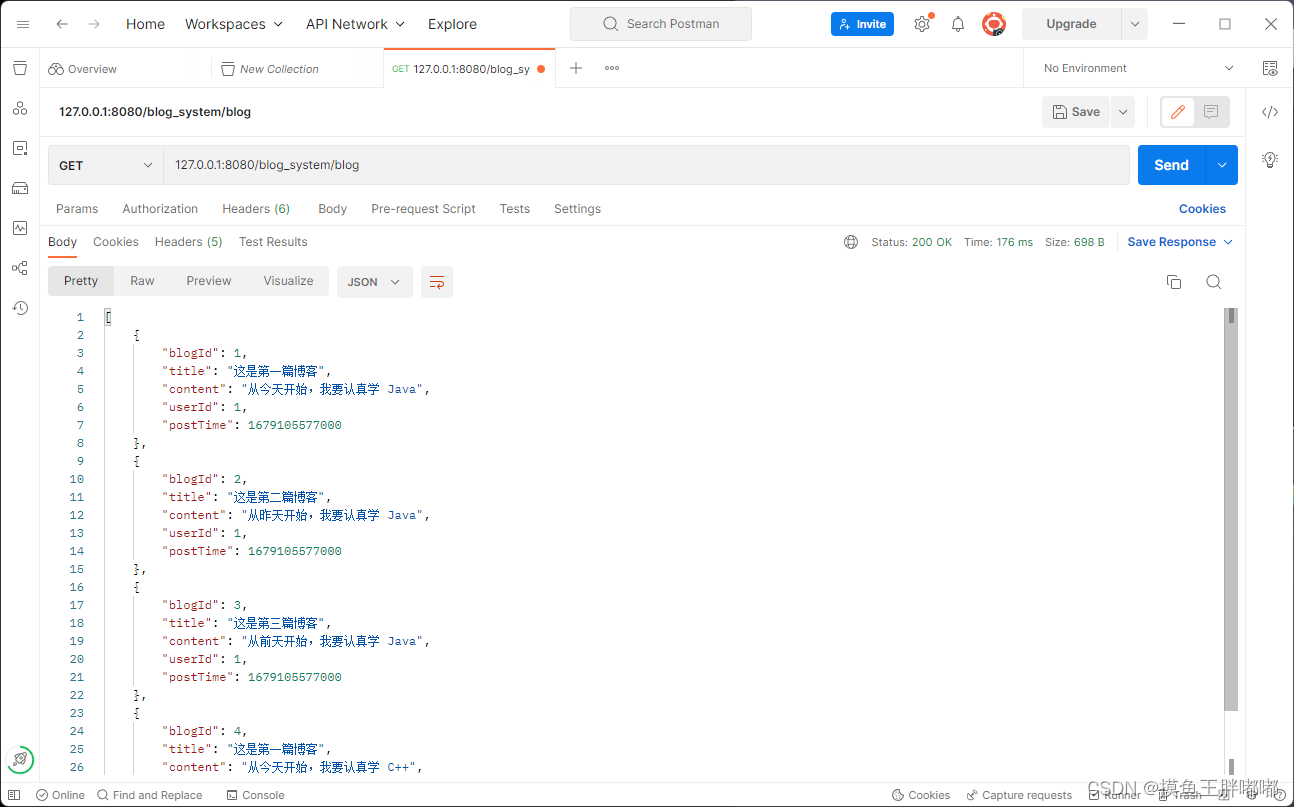
此处得到的响应,和预期的效果,有一点点差别,时间格式~
预期得到的是一个格式化时间,实际上得到一个毫秒时间戳
此处就需要把时间戳转成格式化时间(可以在前端来做,也可以在后端来做)
这里在后端来改!
在Blog类中:
public String getPostTime() {
// 使用 SimpleDateFormat 来完成时间戳到格式化日期的转换
// 这个转换过程,需要在构造方法中指定要转换格式,然后调用format来进行转换
SimpleDateFormat simpleDateFormat = new SimpleDateFormat("yyyy-MM-dd HH:mm:ss");
return simpleDateFormat.format(postTime);
}

这里就看到我们的格式改变了~
编写客户端代码
在页面加载的时候,让页面通过ajax访问服务器,获取到数据库中的博客数据,并且填写到页面中!
处理服务器响应的逻辑:
<script src="http://libs.baidu.com/jquery/2.0.0/jquery.min.js"></script>
<script>
// 在页面加载的时候,通过 ajax 给服务器发送数据,获取到博客列表信息,并且显示在页面上
function getBlogList() {
$.ajax({
type: 'get',
url: 'blog',
success: function(body) {
// 获取到的 body 就是一个 js 对象数组,每个元素就是一个 js 对象,根据这个对象来构造一个div
// 1. 先把 .right 里原有的内容清空
let rightDiv = document.querySelector('.right');
rightDiv.innerHTML = '';
// 2. 遍历 body,构造出一个个的 blogDiv
for (let blog of body) {
let blogDiv = document.createElement('div');
blogDiv.className = 'blog';
let titleDiv = document.createElement('div');
titleDiv.className = 'title';
titleDiv.innerHTML = blog.title;
blogDiv.appendChild(titleDiv);
// 构造发布时间
let dateDiv = document.createElement('div');
dateDiv.className = 'date';
dateDiv.innerHTML = blog.postTime;
blogDiv.appendChild(dateDiv);
// 构造博客的摘要
let descDiv = document.createElement('div');
descDiv.className = 'desc';
descDiv.innerHTML = blog.content;
blogDiv.appendChild(descDiv);
// 构造查看全文
let a = document.createElement('a');
a.innerHTML = '查看全文 >>';
// 此处希望点击之后能够跳转博客详情页
// 这个跳转过程需要告知服务器要访问哪个博客的详情页
a.href = 'blog_detail.html?blogId=' + blog.blogId;
blogDiv.appendChild(a);
// 把 blodDiv 挂到 dom树上
rightDiv.appendChild(blogDiv);
}
},
error: function() {
alert("获取博客列表失败!")
}
});
}
getBlogList();
</script>
完整代码:
<!DOCTYPE html>
<html lang="en">
<head>
<meta charset="UTF-8">
<meta http-equiv="X-UA-Compatible" content="IE=edge">
<meta name="viewport" content="width=device-width, initial-scale=1.0">
<title>博客列表页</title>
<link rel="stylesheet" href="css/common.css">
<link rel="stylesheet" href="css/blog_list.css">
</head>
<body>
<!-- 这是导航栏 -->
<div class="nav">
<img src="image/log.jpg" alt="">
<span>我的博客系统</span>
<!-- 空白元素,用来占位置 -->
<div class="spacer"></div>
<a href="blog_list.html">主页</a>
<a href="blog_edit.html">写博客</a>
<a href="#">注销</a>
</div>
<div class="container">
<!-- 左侧个人信息 -->
<div class="left">
<!-- 表示整个用户信息区 -->
<div class="card">
<img src="image/2.jpg" alt="">
<h3>摸鱼王胖嘟嘟</h3>
<a href="#">gitee 地址</a>
<div class="counter">
<span>文章</span>
<span>分类</span>
</div>
<div class="counter">
<span>2</span>
<span>1</span>
</div>
</div>
</div>
<!-- 右侧个人信息 -->
<div class="right">
<!-- .blog就对应一个博客 -->
<div class="blog">
<!-- 博客标题 -->
<div class="title">
我的第一篇博客
</div>
<!-- 博客发布时间 -->
<div class="date">
2023-02-11 18:26:00
</div>
<!-- 博客摘要 -->
<div class="desc">
从今天起,我要认真敲代码. Lorem, ipsum dolor sit amet consectetur adipisicing elit. Neque exercitationem, ut doloribus blanditiis, eveniet earum culpa accusamus rem eum cum deleniti, quisquam expedita distinctio tempora quaerat adipisci officia esse reprehenderit.
</div>
<a href="#">查看全文 ></a>
</div>
<!-- .blog就对应一个博客 -->
<div class="blog">
<!-- 博客标题 -->
<div class="title">
我的第一篇博客
</div>
<!-- 博客发布时间 -->
<div class="date">
2023-02-11 18:26:00
</div>
<!-- 博客摘要 -->
<div class="desc">
从今天起,我要认真敲代码. Lorem, ipsum dolor sit amet consectetur adipisicing elit. Neque exercitationem, ut doloribus blanditiis, eveniet earum culpa accusamus rem eum cum deleniti, quisquam expedita distinctio tempora quaerat adipisci officia esse reprehenderit.
</div>
<a href="#">查看全文 >></a>
</div>
</div>
<script src="http://libs.baidu.com/jquery/2.0.0/jquery.min.js"></script>
<script>
// 在页面加载的时候,通过 ajax 给服务器发送数据,获取到博客列表信息,并且显示在页面上
function getBlogList() {
$.ajax({
type: 'get',
url: 'blog',
success: function(body) {
// 获取到的 body 就是一个 js 对象数组,每个元素就是一个 js 对象,根据这个对象来构造一个div
// 1. 先把 .right 里原有的内容清空
let rightDiv = document.querySelector('.right');
rightDiv.innerHTML = '';
// 2. 遍历 body,构造出一个个的 blogDiv
for (let blog of body) {
let blogDiv = document.createElement('div');
blogDiv.className = 'blog';
let titleDiv = document.createElement('div');
titleDiv.className = 'title';
titleDiv.innerHTML = blog.title;
blogDiv.appendChild(titleDiv);
// 构造发布时间
let dateDiv = document.createElement('div');
dateDiv.className = 'date';
dateDiv.innerHTML = blog.postTime;
blogDiv.appendChild(dateDiv);
// 构造博客的摘要
let descDiv = document.createElement('div');
descDiv.className = 'desc';
descDiv.innerHTML = blog.content;
blogDiv.appendChild(descDiv);
// 构造查看全文
let a = document.createElement('a');
a.innerHTML = '查看全文 >>';
// 此处希望点击之后能够跳转博客详情页
// 这个跳转过程需要告知服务器要访问哪个博客的详情页
a.href = 'blog_detail.html?blogId=' + blog.blogId;
blogDiv.appendChild(a);
// 把 blodDiv 挂到 dom树上
rightDiv.appendChild(blogDiv);
}
},
error: function() {
alert("获取博客列表失败!")
}
});
}
getBlogList();
</script>
</body>
</html>
BlogDao.java逻辑的处理
package model;
import java.sql.Connection;
import java.sql.PreparedStatement;
import java.sql.ResultSet;
import java.sql.SQLException;
import java.util.ArrayList;
import java.util.List;
// 用于去封装博客表的基本操作
public class BlogDao {
// 1. 往博客表里,插入一个博客.
public void insert(Blog blog) {
// JDBC 基本代码~
Connection connection = null;
PreparedStatement statement = null;
try {
// 1) 和数据库建立连接
connection = DBUtil.getConnection();
// 2) 构造 SQL 语句
String sql = "insert into blog values(null, ?, ?, ?, now())";
statement = connection.prepareStatement(sql);
statement.setString(1, blog.getTitle());
statement.setString(2, blog.getContent());
statement.setInt(3, blog.getUserId());
// 3) 执行 SQL
statement.executeUpdate();
} catch (SQLException e) {
throw new RuntimeException(e);
} finally {
// 4) 关闭连接,释放资源
DBUtil.close(connection, statement, null);
}
}
// 2. 能够获取到博客表中的所有博客表的信息(用于博客列表页),此处每篇博客不一定获取到完整的正文
public List<Blog> selectAll() {
List<Blog> blogs = new ArrayList<>();
Connection connection = null;
PreparedStatement statement = null;
ResultSet resultSet = null;
try {
connection = DBUtil.getConnection();
String sql = "select * from blog";
statement = connection.prepareStatement(sql);
resultSet = statement.executeQuery();
while (resultSet.next()) {
Blog blog = new Blog();
blog.setBlogId(resultSet.getInt("blogId"));
blog.setTitle(resultSet.getString("title"));
blog.setContent(resultSet.getString("content"));
blog.setUserId(resultSet.getShort("userId"));
blog.setPostTime(resultSet.getTimestamp("postTime"));
blogs.add(blog);
}
} catch (SQLException e) {
throw new RuntimeException(e);
} finally {
DBUtil.close(connection, statement, resultSet);
}
return blogs;
}
// 3. 能够根据博客 id 获取到指定的博客内容(用于博客详情页)
public Blog selectOne(int blogId) {
Connection connection = null;
PreparedStatement statement = null;
ResultSet resultSet = null;
try {
connection = DBUtil.getConnection();
String sql = "select * from blog where blogId = ?";
statement = connection.prepareStatement(sql);
statement.setInt(1, blogId);
resultSet = statement.executeQuery();
// 此处我们是使用 主键 来作为查询条件的,查询结果,要么是1,要么是0
if (resultSet.next()) {
Blog blog = new Blog();
blog.setBlogId(resultSet.getInt("blogId"));
blog.setTitle(resultSet.getString("title"));
// 这里需要针对内容进行截断(太长了,就去掉后面)
String content = resultSet.getString("content");
if (content.length() > 50) {
content = content.substring(0, 50) + "...";
}
blog.setContent(content);
blog.setUserId(resultSet.getShort("userId"));
blog.setPostTime(resultSet.getTimestamp("postTime"));
return blog;
}
} catch (SQLException e) {
throw new RuntimeException(e);
} finally {
DBUtil.close(connection, statement, resultSet);
}
return null;
}
// 4. 从博客表中,根据博客id删除博客.
public void delete(int blogId) {
Connection connection = null;
PreparedStatement statement = null;
try {
connection = DBUtil.getConnection();
String sql = "delete from blog where blogId = ?";
statement = connection.prepareStatement(sql);
statement.setInt(1, blogId);
statement.executeUpdate();
} catch (SQLException e) {
throw new RuntimeException(e);
} finally {
DBUtil.close(connection, statement, null);
}
}
// 注意,上述操作是增删查,没有改~
}
问题一:
当前这个博客列表页,还有点小问题~
当前拿到的博客列表顺序,是不太科学的
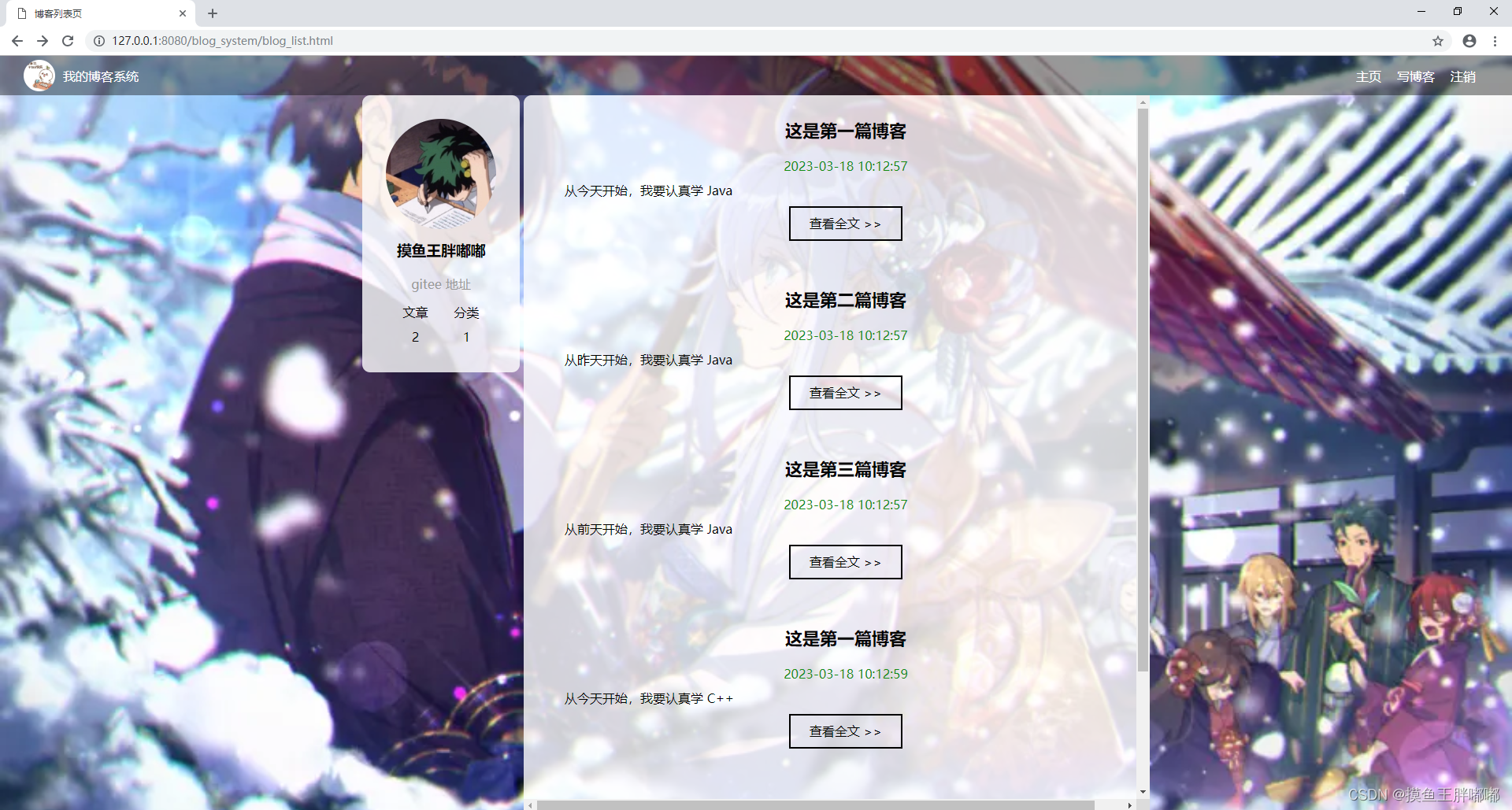
需要保证我们最新的博客得在最上面才行~
如果在sql中没有指定 order by ~ 此时查询到的结果是不确定的~
因此,在sql中不加 order by 之前,是不应该依赖查询结果的顺序的~
在BlogDao.java中找到此处

可以看到是降序排序的了
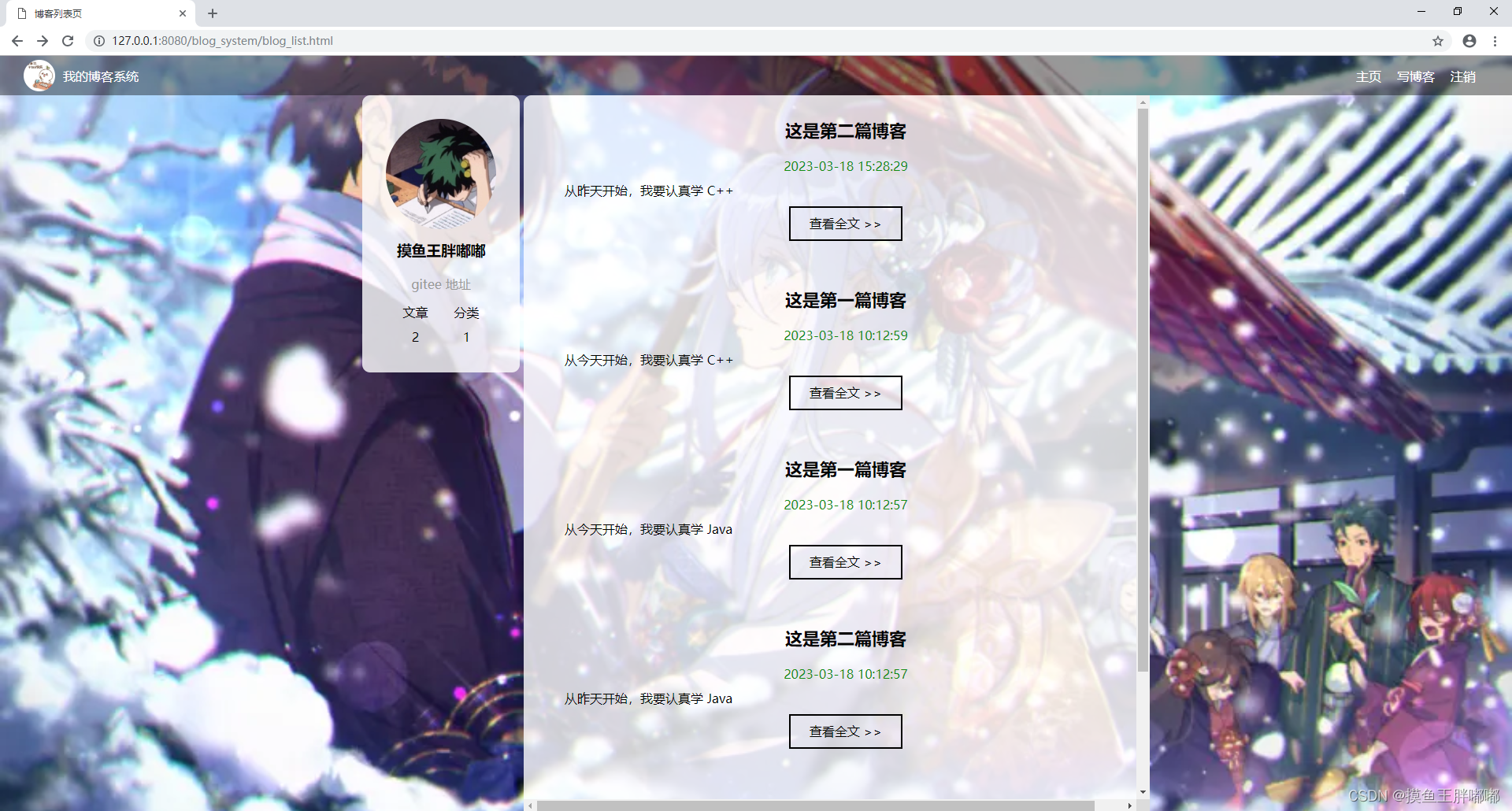
问题二:刷新页面的时候,发现一哆嗦~
旧的内容(测试时写死的数据) => 新的内容(从数据库里查的数据)
是通过网络交互的,花个几十 ms 都是很正常的,人眼是能捕捉到这个变化的~
直接把旧的测试数据删了就行了~
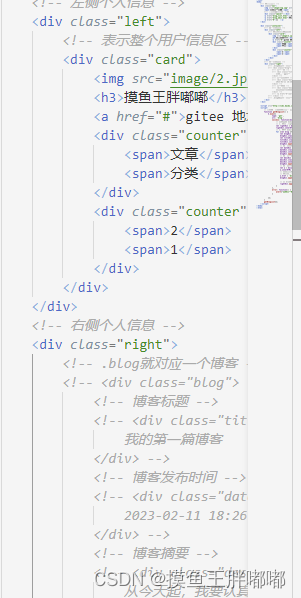
像这样~~

博客详情页
约定前后端交互接口
请求:
GET /blog?blogId= 1
响应:
HTTP/1.1 200 OK
Content-Type: application/json;
{
blogId: 1,
title: “第一篇博客”,
content: "这是正文",
userId: 1,
postTime: '2023-03-18 15:58:00'
}
和获取博客列表的区别~
1.请求里面,带有参数,blogId
2.响应结果不是json数组了,而只是单一的对象
3.响应的博客正文,不再截断了。
获取博客列表的请求
GET/ blog
不带参数的~
package controller;
import com.fasterxml.jackson.databind.ObjectMapper;
import model.Blog;
import model.BlogDao;
import javax.servlet.ServletException;
import javax.servlet.annotation.WebServlet;
import javax.servlet.http.HttpServlet;
import javax.servlet.http.HttpServletRequest;
import javax.servlet.http.HttpServletResponse;
import java.io.IOException;
import java.util.List;
// 通过这个类,来处理 /blog 的对应请求
@WebServlet("/blog")
public class BlogServlet extends HttpServlet {
private ObjectMapper objectMapper = new ObjectMapper();
// 这个方法用来获取到数据库中的博客列表
@Override
protected void doGet(HttpServletRequest req, HttpServletResponse resp) throws ServletException, IOException {
resp.setContentType("application/json;charset=utf8");
BlogDao blogDao = new BlogDao();
// 先尝试获取到 req 中的 blogId参数,如果该参数存在,说明要请求博客详情
// 如果不存在,就说明要请求博客列表
String pararm = req.getParameter("blogId");
if (pararm == null) {
// 不存在参数,获取博客列表
// 从数据库中查询到博客列表,转成JSON格式 然后直接返回即可
List<Blog> blogs = blogDao.selectAll();
// 把 blogs 对象转成JSON格式
String respJson = objectMapper.writeValueAsString(blogs);
resp.getWriter().write(respJson);
} else {
// 存在参数,获取博客详情
int blogId = Integer.parseInt(pararm);
Blog blog = blogDao.selectOne(blogId);
String respJson = objectMapper.writeValueAsString(blog);
resp.getWriter().write(respJson);
}
}
}
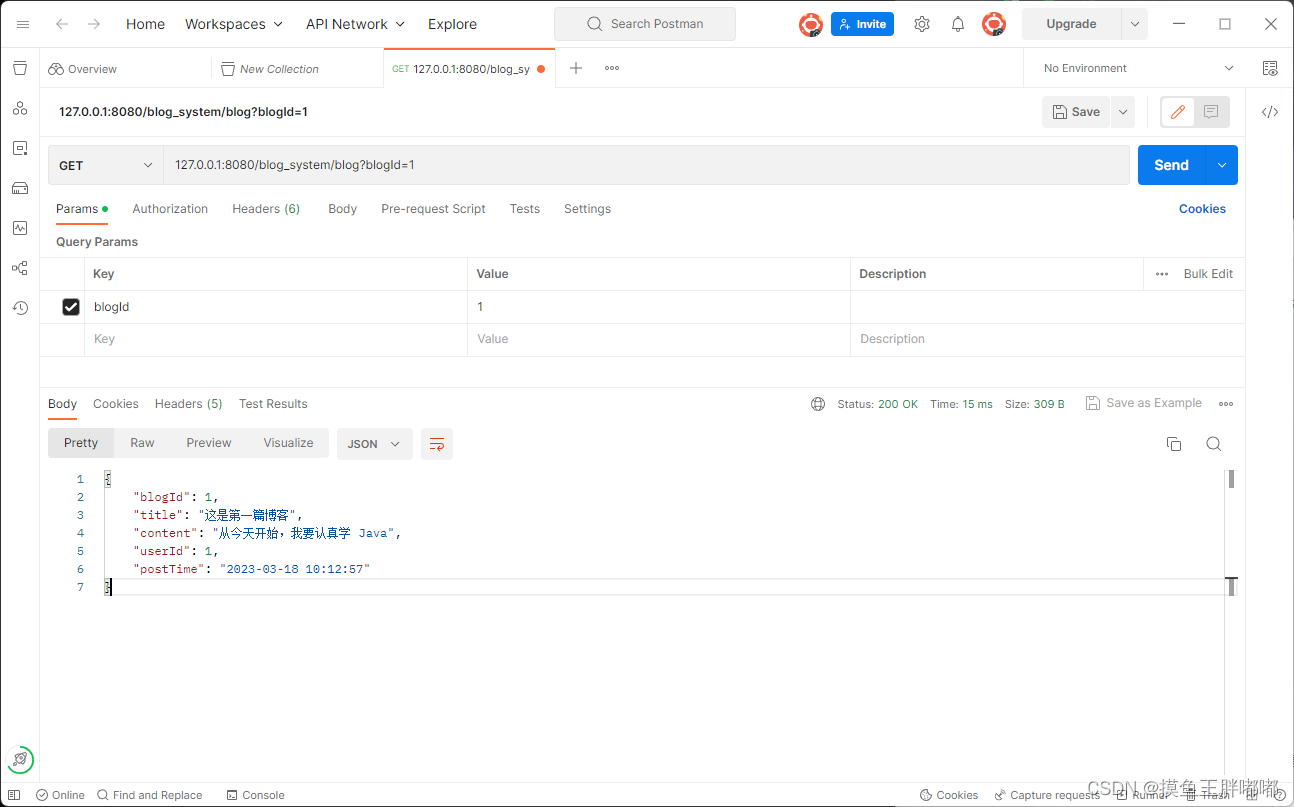
后端代码实现和博客列表页的获取,基本相同,就直接放到一个方法中来实现了,使用blogId参数来区分是获取博客列表还是详情~
前端代码
修改blog_detail.html,让这个页面加载的时候,能够调用上述接口,来从服务器获取到博客数据!
在前端代码这边,要想构造一个请求获取博客详情,就得知道当前用户点击的博客的id!
这个id就已经包含在 当前的 blog_detail.html页面的url里面了~

希望在博客详情页拿到博客的具体内容。
就需要构造一个请求 /blog?blogId=5
这个请求是 blog_detail.html通过ajax发送的
blog_detail.html就需要构造出blogId(5)的这个参数
关键问题就是这个参数(5)从哪里来的呢?
其实当来到blog_detail.html这个页面的时候,url里就已经带上了这个参数~
通过location.search就能够拿到?blogId=5这段内容,从而构造出/blog?blogId=5这样的请求。



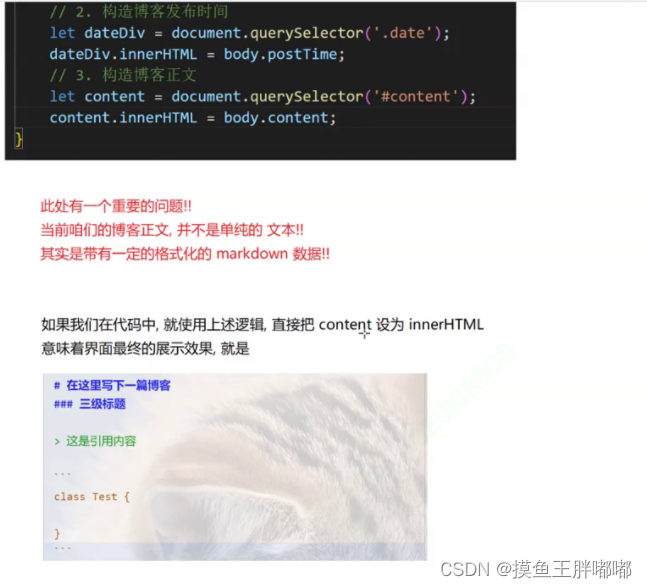
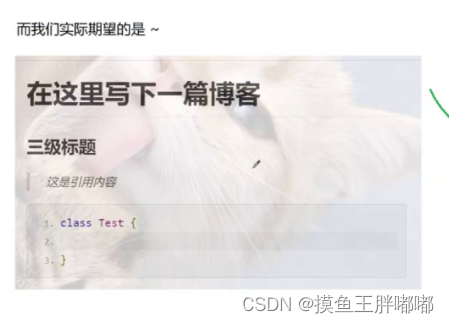
既然如此,那应该如何处理?能够让我们这里的markdown文本内容,被渲染成带有特定样式的html片段呢?
仍然要使用edlitor.md这个库来实现。
这个库不仅提供了markdown编辑器,也提供了渲染功能~
当我们在进行程序验证的时候,要时刻牢记,浏览器缓存可能会影响到结果.
之前已经访问过blog_detail页面了,因此浏览器就可能把这个页面给保存到本地.
下次再尝试访问的时候就直接访问本地内容了。
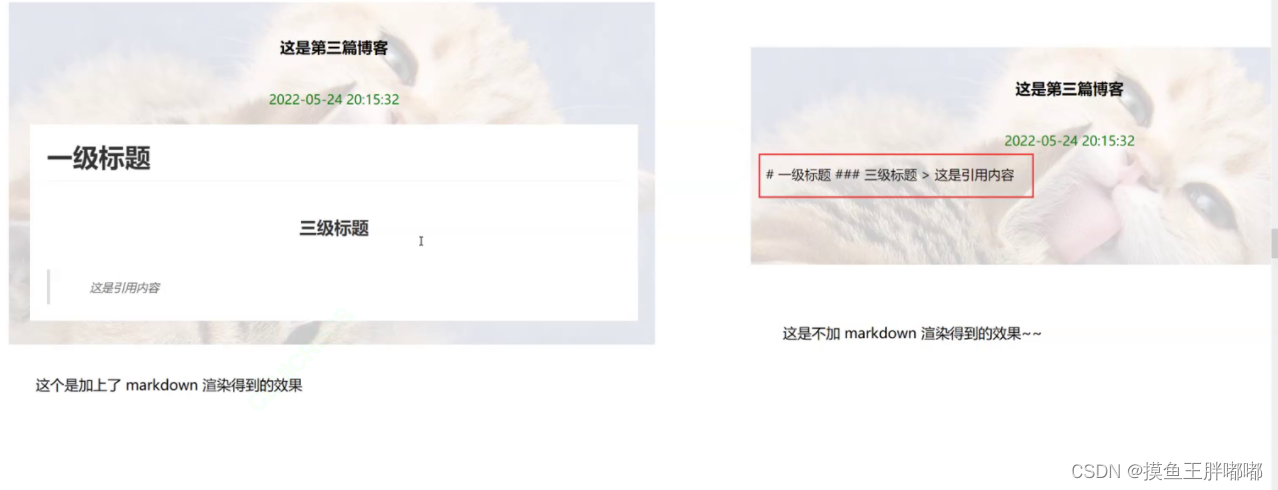
<!DOCTYPE html>
<html lang="en">
<head>
<meta charset="UTF-8">
<meta http-equiv="X-UA-Compatible" content="IE=edge">
<meta name="viewport" content="width=device-width, initial-scale=1.0">
<title>博客详情页</title>
<link rel="stylesheet" href="css/common.css">
<link rel="stylesheet" href="css/blog_detail.css">
<!-- 引入 editor.md 的依赖 -->
<link rel="stylesheet" href="editor.md/css/editormd.min.css" />
<script src="js/jquery.min.js"></script>
<script src="editor.md/lib/marked.min.js"></script>
<script src="editor.md/lib/prettify.min.js"></script>
<script src="editor.md/editormd.js"></script>
</head>
<body>
<!-- 这是导航栏 -->
<div class="nav">
<img src="image/log.jpg" alt="">
<span>我的博客系统</span>
<!-- 空白元素,用来占位置 -->
<div class="spacer"></div>
<a href="blog_list.html">主页</a>
<a href="blog_edit.html">写博客</a>
<a href="#">注销</a>
</div>
<div class="container">
<!-- 左侧个人信息 -->
<div class="left">
<!-- 表示整个用户信息区 -->
<div class="card">
<img src="image/2.jpg" alt="">
<h3>摸鱼王胖嘟嘟</h3>
<a href="#">gitee 地址</a>
<div class="counter">
<span>文章</span>
<span>分类</span>
</div>
<div class="counter">
<span>2</span>
<span>1</span>
</div>
</div>
</div>
<!-- 右侧个人信息 -->
<div class="right">
<!-- 使用这个 div 来包裹整个博客内容详情 -->
<div class="blog-content">
<!-- 博客标题 -->
<h3></h3>
<!-- 博客的时间 -->
<div class="date"></div>
<!-- 博客的正文内容 -->
<div id="content" style="opacity: 80%">
</div>
</div>
</div>
<script>
function getBlogDetail() {
$.ajax({
type: 'get',
// location.search 拿到了形如 '?blogId=5' 这样的一段内容
url: 'blog'+ location.search,
success: function(body) {
// 根据 body 中的内容来构造页面
// 1. 构造博客标题
let h3 = document.querySelector(".blog-content>h3");
h3.innerHTML = body.title;
// 2. 构造博客发布时间
let dateDiv = document.querySelector('.date');
dateDiv.innerHTML = body.postTime;
// 3. 构造博客正文
// 如果直接把content设为 innerHtML,此时展示在界面上的内容是原始的markdown字符串
// 咱们需要的是渲染后的,带有格式的效果
// let content = document.querySelector('#content');
// content.innerHTML = body.content;
// 第一个参数对应 id=content 的html标签,渲染后得到的HTML片段就会放到这个标签下
editormd.markdownToHTML('content', {
markdown: body.content
});
}
});
}
getBlogDetail();
</script>
</div>
</body>
</html>
当前已经把博客列表页和详情页搞出来了
接下来来写登录页
登录页
约定前后端交互接口
请求:
POST /login
Content-Type: application/x-ww-form-urlencoded
这里的逻辑,可以直接使用form表单来进行提交,没必要非要使用ajax~
username=zhangsan&password=123
响应:
HTTP/1.1 302
Location:blog.list.html
当登录成功之后,就自动跳转到,主页(博客列表页)
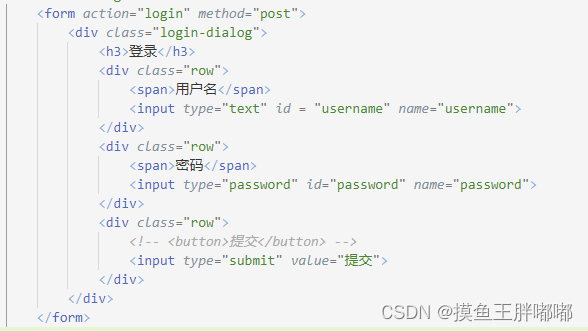
1)给这部分代码套上一层form标签!
给input加上name属性
2)username=zhangsan&password=123
3)把button按钮换成input标签
在前端页面开发的过程中,html页面结构,是非常重要的,后续的CSS和JS很多都依赖了这个页面的结构
一旦页面结构发生了调整,就可能导致CSS或者js失效
<!DOCTYPE html>
<html lang="en">
<head>
<meta charset="UTF-8">
<meta http-equiv="X-UA-Compatible" content="IE=edge">
<meta name="viewport" content="width=device-width, initial-scale=1.0">
<title>登录页面</title>
<link rel="stylesheet" href="css/common.css">
<link rel="stylesheet" href="css/blog_login.css">
</head>
<body>
<!-- 这是导航栏 -->
<div class="nav">
<img src="image/log.jpg" alt="">
<span>我的博客系统</span>
<!-- 空白元素,用来占位置 -->
<div class="spacer"></div>
<a href="blog_list.html">主页</a>
<a href="blog_edit.html">写博客</a>
<!-- 注销页面没必要在登陆页面展示 -->
<!-- <a href="#">注销</a> -->
</div>
<div class="login-container">
<form action="login" method="post">
<div class="login-dialog">
<h3>登录</h3>
<div class="row">
<span>用户名</span>
<input type="text" id = "username" name="username">
</div>
<div class="row">
<span>密码</span>
<input type="password" id="password" name="password">
</div>
<div class="row">
<!-- <button>提交</button> -->
<input type="submit" id="submit" value="提交">
</div>
</div>
</form>
</div>
</body>
</html>
/* 登录页面的专用样式文件 */
.login-container {
width: 100%;
height: calc(100% - 50px);
/* 需要让里面的子元素垂直水平居中 */
display: flex;
align-items: center;
justify-content: center;
}
.login-dialog {
width: 400px;
height: 350px;
background-color: rgba(255, 255, 255, 0.8);
border-radius: 10px;
}
.login-dialog h3 {
text-align: center;
padding: 50px 0;
}
.login-dialog .row {
height: 50px;
width: 100%;
display: flex;
align-items: center;
justify-content: center;
}
.login-dialog .row span {
/* 把span转换成块级元素,方便设置尺寸 */
display: block;
width: 100px;
font-weight: 700;
}
#username, #password {
width: 200px;
height: 40px;
font-size: 22px;
line-height: 40px;
padding-left: 10px;
border-radius: 10px;
/* 去掉边框 */
border: none;
/* 去掉轮廓线 */
outline: none;
}
.row #submit {
width: 300px;
height: 50px;
border-radius: 10px;
color: white;
background-color: rgb(0,128,0);
border: none;
outline: none;
margin-top: 50px;
}
.row #submit:active {
background-color: #666;
}
后端逻辑
此处约定的路径是/login,这是一个新的路径,就需要使用一个新的servlet来处理

使用getPararmeter读取参数的时候,如果参数的值是纯英文,那还好,一般没啥问题。
如果参数的值是中文,此时直接读取参数,很容易出现乱码
中文就涉及到乱码。

但是Servlet默认并不是按照utf8来解析的~
package controller;
import model.User;
import model.UserDao;
import javax.servlet.ServletException;
import javax.servlet.annotation.WebServlet;
import javax.servlet.http.HttpServlet;
import javax.servlet.http.HttpServletRequest;
import javax.servlet.http.HttpServletResponse;
import javax.servlet.http.HttpSession;
import java.io.IOException;
@WebServlet("/login")
public class LoginServlet extends HttpServlet {
@Override
protected void doPost(HttpServletRequest req, HttpServletResponse resp) throws ServletException, IOException {
req.setCharacterEncoding("utf8");
resp.setCharacterEncoding("utf8");
// 1. 获取到请求中的参数
String username = req.getParameter("username");
String password = req.getParameter("password");
System.out.println("username=" + username + ", password=" + password);
if (username == null || "".equals(username) || password == null || "".equals(password)) {
// 请求的内容缺失,肯定是登录失败~
resp.setContentType("text/html; charset=utf8");
resp.getWriter().write("当前的用户名或密码为空!");
return;
}
// 2. 和数据库中的内容进行比较
UserDao userDao = new UserDao();
User user = userDao.selectByName(username);
if (user == null || !user.getPassword().equals(password)) {
// 用户没有查到或者密码不匹配,也是登录失败
resp.setContentType("text/html; charset=utf8");
resp.getWriter().write("用户名或密码错误!");
return;
}
// 3. 如果比较通过,就创建会话.
HttpSession session = req.getSession(true);
// 把刚才的用户信息,存储到会话中
session.setAttribute("user", user);
// 4. 返回一个重定向报文,跳转到博客列表页
resp.sendRedirect("blog_list.html");
}
}
当登录功能完成之后,就需要调整一下之前的两个页面(博客列表和博客详情)
让这两个页面,必须登录后才能访问~~
此处就做出这样的限制~(这样限制一下,后面实现一些其他功能会更简单)
在进入博客列表页/详情页的时候,先检查一下用户的登录状态~如果用户当前已经是登录状态,才能继续使用,如果是未登录状态,则强制跳转到login页面
如何实现上述功能?
可以在博客列表页/详情页,加载的时候,通过ajax访问一下服务器,获取当前的登录状态~看能不能获取到,如果获取到了,就说明当前确实是已经登录了。此时就可以留在这个页面了。
如果没有获取到,说明就未登录。就需要跳转到登录页面~
约定前后端交互接口
请求:
GET /login
响应:
HTTP/1.1 200 OK
Content-Type:application/json
{
userId: 1,
username: 'zhangsan',
}
登录了,就直接返回当前登录的用户信息.
未登录,则直接返回一个userId为0的对象
{
userId: 0,
username: '',
}
此处只是一种典型的约定方式,完全也可以采用其他的方式来约定~
比如使用403表示当前未登录~
package controller;
import com.fasterxml.jackson.databind.ObjectMapper;
import model.User;
import model.UserDao;
import javax.servlet.ServletException;
import javax.servlet.annotation.WebServlet;
import javax.servlet.http.HttpServlet;
import javax.servlet.http.HttpServletRequest;
import javax.servlet.http.HttpServletResponse;
import javax.servlet.http.HttpSession;
import java.io.IOException;
@WebServlet("/login")
public class LoginServlet extends HttpServlet {
private ObjectMapper objectMapper = new ObjectMapper();
@Override
protected void doPost(HttpServletRequest req, HttpServletResponse resp) throws ServletException, IOException {
req.setCharacterEncoding("utf8");
resp.setCharacterEncoding("utf8");
// 1. 获取到请求中的参数
String username = req.getParameter("username");
String password = req.getParameter("password");
System.out.println("username=" + username + ", password=" + password);
if (username == null || "".equals(username) || password == null || "".equals(password)) {
// 请求的内容缺失,肯定是登录失败~
resp.setContentType("text/html; charset=utf8");
resp.getWriter().write("当前的用户名或密码为空!");
return;
}
// 2. 和数据库中的内容进行比较
UserDao userDao = new UserDao();
User user = userDao.selectByName(username);
if (user == null || !user.getPassword().equals(password)) {
// 用户没有查到或者密码不匹配,也是登录失败
resp.setContentType("text/html; charset=utf8");
resp.getWriter().write("用户名或密码错误!");
return;
}
// 3. 如果比较通过,就创建会话.
HttpSession session = req.getSession(true);
// 把刚才的用户信息,存储到会话中
session.setAttribute("user", user);
// 4. 返回一个重定向报文,跳转到博客列表页
resp.sendRedirect("blog_list.html");
}
// 这个方法用来让前端检测当前的登录状态
@Override
protected void doGet(HttpServletRequest req, HttpServletResponse resp) throws ServletException, IOException {
resp.setContentType("application/json;charset=utf8");
HttpSession session = req.getSession(false);
if (session == null) {
// 检测下会话是否存在,不存在说明未登录!
User user = new User();
resp.getWriter().write(objectMapper.writeValueAsString(user));
return;
}
User user = (User) session.getAttribute("user");
if (user == null) {
// 虽然有会话,但是会话里没有 user 对象,也视为未登录
user = new User();
resp.getWriter().write(objectMapper.writeValueAsString(user));
return;
}
// 已经登录的状态!
// 注意,此处不要把密码返回到前端
user.setPassword("");
resp.getWriter().write(objectMapper.writeValueAsString(user));
}
}
前端代码:
<!DOCTYPE html>
<html lang="en">
<head>
<meta charset="UTF-8">
<meta http-equiv="X-UA-Compatible" content="IE=edge">
<meta name="viewport" content="width=device-width, initial-scale=1.0">
<title>博客列表页</title>
<link rel="stylesheet" href="css/common.css">
<link rel="stylesheet" href="css/blog_list.css">
</head>
<body>
<!-- 这是导航栏 -->
<div class="nav">
<img src="image/log.jpg" alt="">
<span>我的博客系统</span>
<!-- 空白元素,用来占位置 -->
<div class="spacer"></div>
<a href="blog_list.html">主页</a>
<a href="blog_edit.html">写博客</a>
<a href="#">注销</a>
</div>
<div class="container">
<!-- 左侧个人信息 -->
<div class="left">
<!-- 表示整个用户信息区 -->
<div class="card">
<img src="image/2.jpg" alt="">
<h3>摸鱼王胖嘟嘟</h3>
<a href="#">gitee 地址</a>
<div class="counter">
<span>文章</span>
<span>分类</span>
</div>
<div class="counter">
<span>2</span>
<span>1</span>
</div>
</div>
</div>
<!-- 右侧个人信息 -->
<div class="right">
<!-- .blog就对应一个博客 -->
<!-- <div class="blog"> -->
<!-- 博客标题 -->
<!-- <div class="title">
我的第一篇博客
</div> -->
<!-- 博客发布时间 -->
<!-- <div class="date">
2023-02-11 18:26:00
</div> -->
<!-- 博客摘要 -->
<!-- <div class="desc">
从今天起,我要认真敲代码. Lorem, ipsum dolor sit amet consectetur adipisicing elit. Neque exercitationem, ut doloribus blanditiis, eveniet earum culpa accusamus rem eum cum deleniti, quisquam expedita distinctio tempora quaerat adipisci officia esse reprehenderit.
</div> -->
<!-- <a href="#">查看全文 ></a> -->
<!-- </div> -->
<!-- .blog就对应一个博客 -->
</div>
</div>
<script src="http://libs.baidu.com/jquery/2.0.0/jquery.min.js"></script>
<script>
// 在页面加载的时候,通过 ajax 给服务器发送数据,获取到博客列表信息,并且显示在页面上
function getBlogList() {
$.ajax({
type: 'get',
url: 'blog',
success: function(body) {
// 获取到的 body 就是一个 js 对象数组,每个元素就是一个 js 对象,根据这个对象来构造一个div
// 1. 先把 .right 里原有的内容清空
let rightDiv = document.querySelector('.right');
rightDiv.innerHTML = '';
// 2. 遍历 body,构造出一个个的 blogDiv
for (let blog of body) {
let blogDiv = document.createElement('div');
blogDiv.className = 'blog';
let titleDiv = document.createElement('div');
titleDiv.className = 'title';
titleDiv.innerHTML = blog.title;
blogDiv.appendChild(titleDiv);
// 构造发布时间
let dateDiv = document.createElement('div');
dateDiv.className = 'date';
dateDiv.innerHTML = blog.postTime;
blogDiv.appendChild(dateDiv);
// 构造博客的摘要
let descDiv = document.createElement('div');
descDiv.className = 'desc';
descDiv.innerHTML = blog.content;
blogDiv.appendChild(descDiv);
// 构造查看全文
let a = document.createElement('a');
a.innerHTML = '查看全文 >>';
// 此处希望点击之后能够跳转博客详情页
// 这个跳转过程需要告知服务器要访问哪个博客的详情页
a.href = 'blog_detail.html?blogId=' + blog.blogId;
blogDiv.appendChild(a);
// 把 blodDiv 挂到 dom树上
rightDiv.appendChild(blogDiv);
}
},
error: function() {
alert("获取博客列表失败!")
}
});
}
getBlogList();
// 加上一个逻辑,通过 GET /login 这个接口来获取下当前的登录状态~
function getUserInfo() {
$.ajax({
type: 'get',
url: 'login',
success: function(body) {
// 判定此处的body是不是一个有效的user对象
if (body.userId && body.userId > 0) {
// 登录成功!
// 不做处理
console.log("当前用户登录成功!用户名:" + body.username);
} else {
// 登录失败!
// 让前端页面,跳转到 login.hmtl
alert("当前您尚未登录!请登录后再访问博客列表!");
location.assign('blog_login.html');
}
},
error: function() {
location.assign('blog_login.html');
}
});
}
getUserInfo();
</script>
</body>
</html>
<!DOCTYPE html>
<html lang="en">
<head>
<meta charset="UTF-8">
<meta http-equiv="X-UA-Compatible" content="IE=edge">
<meta name="viewport" content="width=device-width, initial-scale=1.0">
<title>博客详情页</title>
<link rel="stylesheet" href="css/common.css">
<link rel="stylesheet" href="css/blog_detail.css">
<!-- 引入 editor.md 的依赖 -->
<link rel="stylesheet" href="editor.md/css/editormd.min.css" />
<script src="js/jquery.min.js"></script>
<script src="editor.md/lib/marked.min.js"></script>
<script src="editor.md/lib/prettify.min.js"></script>
<script src="editor.md/editormd.js"></script>
</head>
<body>
<!-- 这是导航栏 -->
<div class="nav">
<img src="image/log.jpg" alt="">
<span>我的博客系统</span>
<!-- 空白元素,用来占位置 -->
<div class="spacer"></div>
<a href="blog_list.html">主页</a>
<a href="blog_edit.html">写博客</a>
<a href="#">注销</a>
</div>
<div class="container">
<!-- 左侧个人信息 -->
<div class="left">
<!-- 表示整个用户信息区 -->
<div class="card">
<img src="image/2.jpg" alt="">
<h3>摸鱼王胖嘟嘟</h3>
<a href="#">gitee 地址</a>
<div class="counter">
<span>文章</span>
<span>分类</span>
</div>
<div class="counter">
<span>2</span>
<span>1</span>
</div>
</div>
</div>
<!-- 右侧个人信息 -->
<div class="right">
<!-- 使用这个 div 来包裹整个博客内容详情 -->
<div class="blog-content">
<!-- 博客标题 -->
<h3></h3>
<!-- 博客的时间 -->
<div class="date"></div>
<!-- 博客的正文内容 -->
<div id="content" style="opacity: 80%">
</div>
</div>
</div>
<script>
function getBlogDetail() {
$.ajax({
type: 'get',
// location.search 拿到了形如 '?blogId=5' 这样的一段内容
url: 'blog'+ location.search,
success: function(body) {
// 根据 body 中的内容来构造页面
// 1. 构造博客标题
let h3 = document.querySelector(".blog-content>h3");
h3.innerHTML = body.title;
// 2. 构造博客发布时间
let dateDiv = document.querySelector('.date');
dateDiv.innerHTML = body.postTime;
// 3. 构造博客正文
// 如果直接把content设为 innerHtML,此时展示在界面上的内容是原始的markdown字符串
// 咱们需要的是渲染后的,带有格式的效果
// let content = document.querySelector('#content');
// content.innerHTML = body.content;
// 第一个参数对应 id=content 的html标签,渲染后得到的HTML片段就会放到这个标签下
editormd.markdownToHTML('content', {
markdown: body.content
});
}
});
}
getBlogDetail();
// 加上一个逻辑,通过 GET /login 这个接口来获取下当前的登录状态~
function getUserInfo() {
$.ajax({
type: 'get',
url: 'login',
success: function(body) {
// 判定此处的body是不是一个有效的user对象
if (body.userId && body.userId > 0) {
// 登录成功!
// 不做处理
console.log("当前用户登录成功!用户名:" + body.username);
} else {
// 登录失败!
// 让前端页面,跳转到 login.hmtl
alert("当前您尚未登录!请登录后再访问博客详情!");
location.assign('blog_login.html');
}
},
error: function() {
location.assign('blog_login.html');
}
});
}
getUserInfo();
</script>
</div>
</body>
</html>
正确显示用户信息
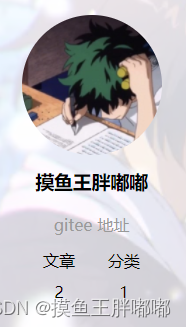
当下用户信息,显示的是”摸鱼王胖嘟嘟“,实际登录的用户,显示”zhangsan“。
针对博客列表页

<!DOCTYPE html>
<html lang="en">
<head>
<meta charset="UTF-8">
<meta http-equiv="X-UA-Compatible" content="IE=edge">
<meta name="viewport" content="width=device-width, initial-scale=1.0">
<title>博客列表</title>
<link rel="stylesheet" href="css/common.css">
<link rel="stylesheet" href="css/blog_list.css">
</head>
<body>
<!-- 这是导航栏 -->
<div class="nav">
<img src="image/log.jpg" alt="">
<span>我的博客系统</span>
<!-- 空白元素, 用来占位置 -->
<div class="spacer"></div>
<a href="blog_list.html">主页</a>
<a href="blog_edit.html">写博客</a>
<a href="#">注销</a>
</div>
<!-- 这里的 .container 作为页面的版心 -->
<div class="container">
<!-- 左侧个人信息 -->
<div class="left">
<!-- 表示整个用户信息区域. -->
<div class="card">
<img src="image/2.jpg" alt="">
<h3></h3>
<a href="#">github 地址</a>
<div class="counter">
<span>文章</span>
<span>分类</span>
</div>
<div class="counter">
<span>2</span>
<span>1</span>
</div>
</div>
</div>
<!-- 右侧内容详情 -->
<div class="right">
<!-- .blog 就对应一个博客 -->
<!-- <div class="blog">
<div class="title">
我的第一篇博客
</div>
<div class="date">
2022-05-05 20:52:00
</div>
<div class="desc">
从今天起, 我要认真敲代码. Lorem ipsum dolor sit amet consectetur adipisicing elit. Nulla alias tenetur ut velit ex voluptatibus consequatur quam exercitationem, assumenda ea blanditiis repudiandae? Repellendus tenetur nostrum asperiores molestias doloremque cupiditate maiores.
</div>
<a href="#">查看全文 >> </a>
</div> -->
</div>
</div>
</div>
<script src="http://libs.baidu.com/jquery/2.0.0/jquery.min.js"></script>
<script>
// 在页面加载的时候, 通过 ajax 给服务器发送数据, 获取到博客列表信息, 并且显示在界面上.
function getBlogList() {
$.ajax({
type: 'get',
url: 'blog',
success: function(body) {
// 获取到的 body 就是一个 js 对象数组, 每个元素就是一个 js 对象, 根据这个对象构造 div
// 1. 先把 .right 里原有的内容给清空
let rightDiv = document.querySelector('.right');
rightDiv.innerHTML = '';
// 2. 遍历 body, 构造出一个个的 blogDiv
for (let blog of body) {
let blogDiv = document.createElement('div');
blogDiv.className = 'blog';
// 构造标题
let titleDiv = document.createElement('div');
titleDiv.className = 'title';
titleDiv.innerHTML = blog.title;
blogDiv.appendChild(titleDiv);
// 构造发布时间
let dateDiv = document.createElement('div');
dateDiv.className = 'date';
dateDiv.innerHTML = blog.postTime;
blogDiv.appendChild(dateDiv);
// 构造博客的摘要
let descDiv = document.createElement('div');
descDiv.className = 'desc';
descDiv.innerHTML = blog.content;
blogDiv.appendChild(descDiv);
// 构造 查看全文
let a = document.createElement('a');
a.innerHTML = '查看全文 >>';
// 此处希望点击之后能够跳转到 博客详情页 !!
// 这个跳转过程需要告知服务器要访问的是哪个博客的详情页.
a.href = 'blog_detail.html?blogId=' + blog.blogId;
blogDiv.appendChild(a);
// 把 blogDiv 挂到 dom 树上!
rightDiv.appendChild(blogDiv);
}
},
error: function() {
alert("获取博客列表失败!");
}
});
}
getBlogList();
</script>
<!-- 在这里引入上述的 js 文件, 就可以执行到里面的代码, 也就进行了登录状态的监测了 -->
<script src="js/common.js"></script>
<script>
// 针对博客列表页, 调用的时候传入参数
getUserInfo('blog_list.html');
</script>
</body>
</html>
针对博客详情页
当前看到的是,博客详情页,用户名,也是成了zhangsan了,此处就需要处理一下,让博客列表页和详情页,能够做出一些区分~
让服务器,提供一个新的接口~这个接口可以让客户端指定blogId,获取到指定blogId的作者信息!
请求:
GET/authorInfo?blogId=6
响应:
{
userId:2,
username: 'lisi',
}
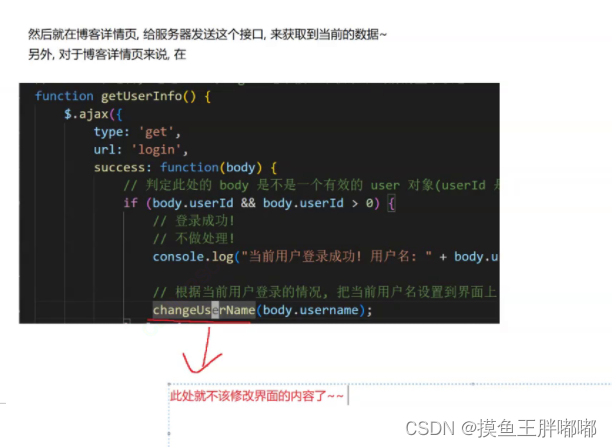

<!DOCTYPE html>
<html lang="en">
<head>
<meta charset="UTF-8">
<meta http-equiv="X-UA-Compatible" content="IE=edge">
<meta name="viewport" content="width=device-width, initial-scale=1.0">
<title>博客详情页</title>
<link rel="stylesheet" href="css/common.css">
<link rel="stylesheet" href="css/blog_detail.css">
<!-- 引入 editor.md 的依赖 -->
<link rel="stylesheet" href="editor.md/css/editormd.min.css" />
<script src="js/jquery.min.js"></script>
<script src="editor.md/lib/marked.min.js"></script>
<script src="editor.md/lib/prettify.min.js"></script>
<script src="editor.md/editormd.js"></script>
</head>
<body>
<!-- 这是导航栏 -->
<div class="nav">
<img src="image/log.jpg" alt="">
<span>我的博客系统</span>
<!-- 空白元素, 用来占位置 -->
<div class="spacer"></div>
<a href="blog_list.html">主页</a>
<a href="blog_edit.html">写博客</a>
<a href="#">注销</a>
</div>
<!-- 这里的 .container 作为页面的版心 -->
<div class="container">
<!-- 左侧个人信息 -->
<div class="left">
<!-- 表示整个用户信息区域. -->
<div class="card">
<img src="image/2.jpg" alt="">
<h3></h3>
<a href="#">github 地址</a>
<div class="counter">
<span>文章</span>
<span>分类</span>
</div>
<div class="counter">
<span>2</span>
<span>1</span>
</div>
</div>
</div>
<!-- 右侧内容详情 -->
<div class="right">
<!-- 使用这个 div 来包裹整个博客的内容详情 -->
<div class="blog-content">
<!-- 博客标题 -->
<h3></h3>
<!-- 博客的时间 -->
<div class="date"></div>
<!-- 博客的正文内容 -->
<div id="content" style="opacity: 80%">
</div>
</div>
</div>
</div>
<script>
function getBlogDetail() {
$.ajax({
type: 'get',
// location.search 拿到了形如 '?blogId=5' 这样的一段内容
url: 'blog' + location.search,
success: function(body) {
// 根据 body 中的内容来构造页面
// 1. 构造博客标题
let h3 = document.querySelector(".blog-content>h3");
h3.innerHTML = body.title;
// 2. 构造博客发布时间
let dateDiv = document.querySelector('.date');
dateDiv.innerHTML = body.postTime;
// 3. 构造博客正文
// 如果直接把 content 设为 innerHTML, 此时展示在界面上的内容, 是原始的 markdown 字符串
// 咱们需要的是渲染后的, 带有格式的效果
// let content = document.querySelector('#content');
// content.innerHTML = body.content;
// 第一个参数对应 id=content 的 html 标签. 渲染后得到的 html 片段就会被放到这个 标签下.
editormd.markdownToHTML('content', {
markdown: body.content
});
}
});
}
getBlogDetail();
// 加上一个逻辑, 通过 GET /login 这个接口来获取下当前的登录状态~
function getUserInfo(pageName) {
$.ajax({
type: 'get',
url: 'login',
success: function(body) {
// 判定此处的 body 是不是一个有效的 user 对象(userId 是否非 0)
if (body.userId && body.userId > 0) {
// 登录成功!
// 不做处理!
console.log("当前用户登录成功! 用户名: " + body.username);
// 在 getUserInfo 的回调函数中, 来调用获取作者信息
getAuthorInfo(body);
} else {
// 登录失败!
// 让前端页面, 跳转到 login.html
alert("当前您尚未登录! 请登录后再访问博客列表!");
location.assign('blog_login.html');
}
},
error: function() {
alert("当前您尚未登录! 请登录后再访问博客列表!");
location.assign('blog_login.html');
}
});
}
// 判定用户的登录状态
getUserInfo("blog_detail.html");
// 从服务器获取一下当前博客的作者信息, 并显示到界面上.
// 参数 user 就是刚才从服务器拿到的当前登录用户的信息
function getAuthorInfo(user) {
$.ajax({
type: 'get',
url: 'authorInfo' + location.search,
success: function(body) {
// 此处的 body, 就是服务器返回的 User 对象, 是文章的作者信息
if (body.username) {
// 如果响应中的 username 存在, 就把这个值设置到页面上.
changeUserName(body.username);
if (body.username == user.username) {
// 作者和登录的用户是一个人, 则显示 "删除按钮"
let navDiv = document.querySelector('.nav');
let a = document.createElement('a');
a.innerHTML = '删除';
// 期望点击删除, 构造一个形如 blogDelete?blogId=6 这样的请求
a.href = 'blogDelete' + location.search;
navDiv.appendChild(a);
}
} else {
console.log("获取作者信息失败! " + body.reason);
}
}
});
}
function changeUserName(username) {
let h3 = document.querySelector('.card>h3');
h3.innerHTML = username;
}
</script>
</body>
</html>
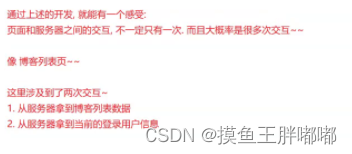
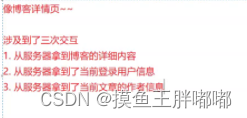
实现"注销"功能
退出当前登录的状态
在导航栏中安排一个“注销”按钮
当用户点击注销之后,就会在服务器上取消登录状态,并且跳转到登录页面。
约定前后端交互接口
请求:
GET / logout
响应:
HTTP/1.1 302
Location:login.html
package controller;
import javax.servlet.ServletException;
import javax.servlet.annotation.WebServlet;
import javax.servlet.http.HttpServlet;
import javax.servlet.http.HttpServletRequest;
import javax.servlet.http.HttpServletResponse;
import javax.servlet.http.HttpSession;
import java.io.IOException;
@SuppressWarnings({"all"})
@WebServlet("/logout")
public class LogoutServlet extends HttpServlet {
@Override
protected void doGet(HttpServletRequest req, HttpServletResponse resp) throws ServletException, IOException {
// 先找到当前用户的会话
HttpSession session = req.getSession(false);
if (session == null) {
// 用户没有登录!谈不上注销!
resp.getWriter().write("当前用户尚未登录,无法注销1");
return;
}
// 然后把这个用户的会话中的信息删掉
session.removeAttribute("user");
resp.sendRedirect("blog_login.html");
}
}
发布博客功能
在博客编辑页中,当用户输入了博客标题,和正文之后,点击发布~
此时就会把博客数据提交到服务器,由服务器存储到数据库中~
约定前后端交互接口
请求:
POST/blog
Content-Type:application/x-www-form-urlencoded
title=这是标题&content=这是正文....
响应:
HTTP/1.1 302
Location:blog_list.html
package controller;
import com.fasterxml.jackson.databind.ObjectMapper;
import model.Blog;
import model.BlogDao;
import model.User;
import javax.servlet.ServletException;
import javax.servlet.annotation.WebServlet;
import javax.servlet.http.HttpServlet;
import javax.servlet.http.HttpServletRequest;
import javax.servlet.http.HttpServletResponse;
import javax.servlet.http.HttpSession;
import java.io.IOException;
import java.util.List;
// 通过这个类,来处理 /blog 的对应请求
@WebServlet("/blog")
public class BlogServlet extends HttpServlet {
private ObjectMapper objectMapper = new ObjectMapper();
// 这个方法用来获取到数据库中的博客列表
@Override
protected void doGet(HttpServletRequest req, HttpServletResponse resp) throws ServletException, IOException {
resp.setContentType("application/json;charset=utf8");
BlogDao blogDao = new BlogDao();
// 先尝试获取到 req 中的 blogId参数,如果该参数存在,说明要请求博客详情
// 如果不存在,就说明要请求博客列表
String pararm = req.getParameter("blogId");
if (pararm == null) {
// 不存在参数,获取博客列表
// 从数据库中查询到博客列表,转成JSON格式 然后直接返回即可
List<Blog> blogs = blogDao.selectAll();
// 把 blogs 对象转成JSON格式
String respJson = objectMapper.writeValueAsString(blogs);
resp.getWriter().write(respJson);
} else {
// 存在参数,获取博客详情
int blogId = Integer.parseInt(pararm);
Blog blog = blogDao.selectOne(blogId);
String respJson = objectMapper.writeValueAsString(blog);
resp.getWriter().write(respJson);
}
}
@Override
protected void doPost(HttpServletRequest req, HttpServletResponse resp) throws ServletException, IOException {
HttpSession session = req.getSession(false);
if (session == null) {
// 当前用户未登录,不能提交博客
resp.setContentType("text/html;charset=utf8");
// 直接告诉客户端,请求参数不对
resp.getWriter().write("当前用户未登录,不能提交博客!");
return;
}
User user = (User) session.getAttribute("user");
if (user == null) {
// 当前用户未登录,不能提交博客
resp.setContentType("text/html;charset=utf8");
// 直接告诉客户端,请求参数不对
resp.getWriter().write("当前用户未登录,不能提交博客!");
return;
}
// 一定哟啊先指定好请求按照哪种编码来解析
req.setCharacterEncoding("utf8");
// 先从请求中,取出参数(博客的标题和正文)
String title = req.getParameter("title");
String content = req.getParameter("content");
if (title == null || "".equals(title) || content == null || "".equals(content)) {
resp.setContentType("text/html;charset=utf8");
// 直接告诉客户端,请求参数不对
resp.getWriter().write("提交博客失败!缺少必要的参数!");
return;
}
// 构造 Blog 对象,把当前的信息填进去,并插入数据库中
// 此处要给 Blog 设置的属性,主要是 title,content,userId
// postTime 和 blogId 都不需要手动指定,都是插入数据库的时候自动生成的
Blog blog = new Blog();
blog.setTitle(title);
blog.setContent(content);
// 作者 id 就是当前提交这个博客的用户的身份信息!
blog.setUserId(user.getUserId());
BlogDao blogDao = new BlogDao();
blogDao.insert(blog);
// 重定向到博客列表页
resp.sendRedirect("blog_list.html");
}
}
这里就需要整一个form表单,把这里的内容给套上!
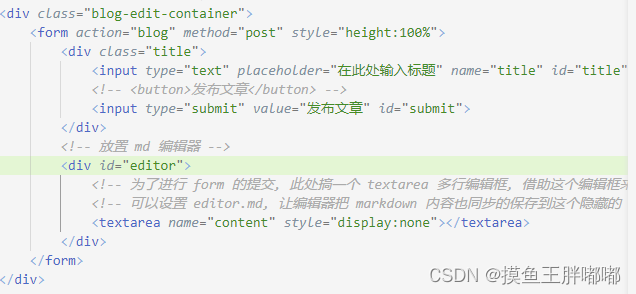
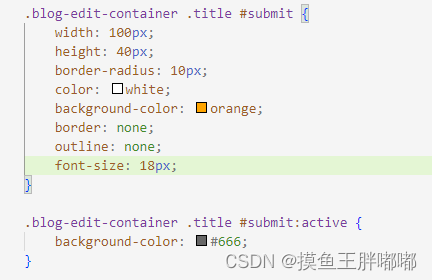
删除博客
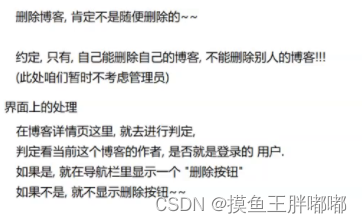
服务器处理
用户点击删除按钮,触发一个HTTP请求,HTTP请求就会让服务器删除指定的博客~
完整代码
完整代码我放gitee仓库了,需要的可以去博客系统仓库找。

